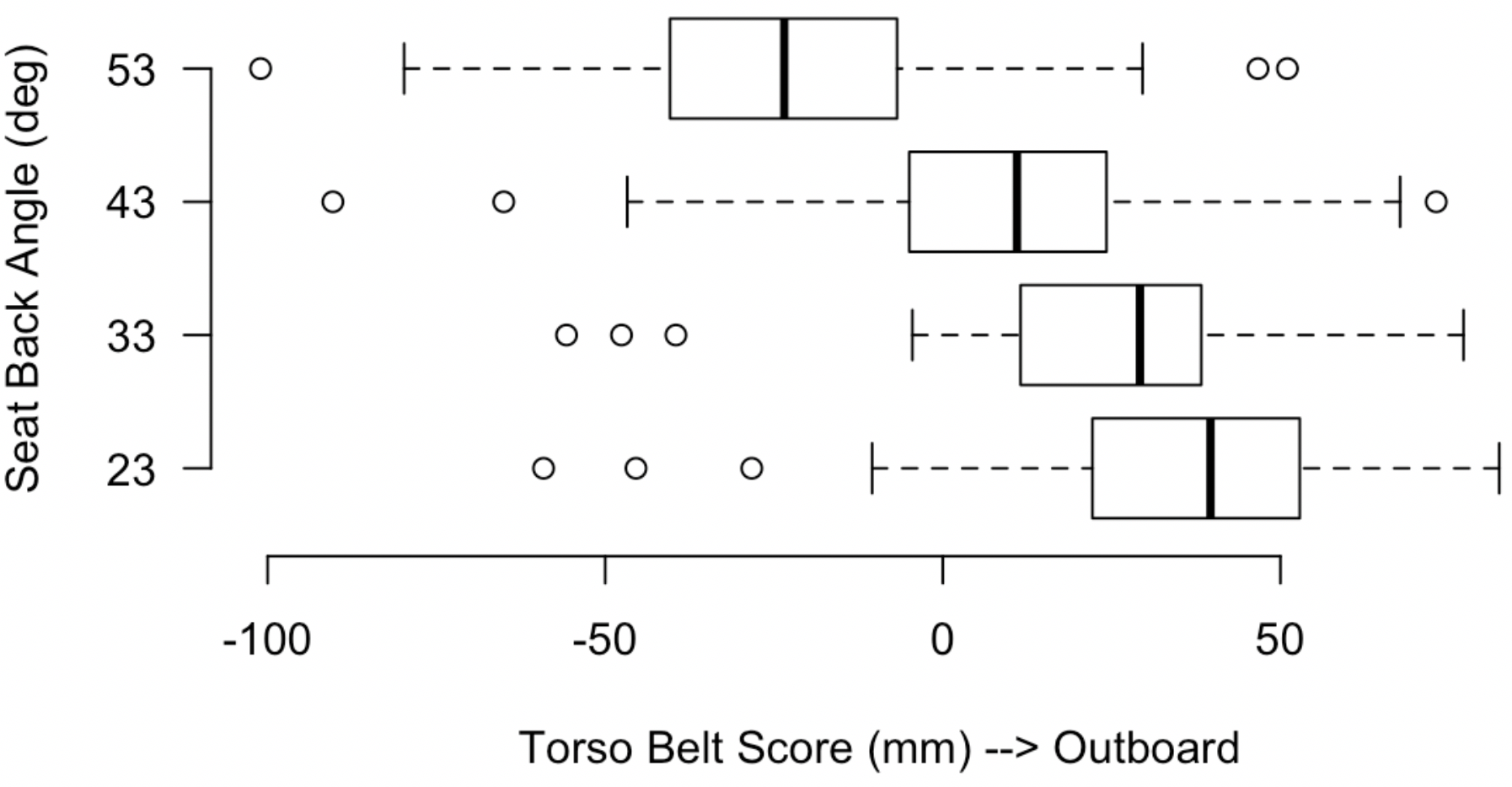>>> Matthew P. Reed

Matthew P. Reed, Ph.D.
I'm the Don B. Chaffin Collegiate Research Professor and Head of the Biosciences Group of the University of Michigan Transportation Research Institute. I conduct research in a variety of areas relating to anthropometry and biomechanics, including vehicle ergonomics and vehicle occupant crash protection. I'm also a Research Professor in the Center for Ergonomics in Industrial and Operations Engineering, where I lead the Human Motion Simulation Laboratory. The HUMOSIM Lab develops movement simulation algorithms and ergonomics analysis tools for use with digital human modeling software.
Follow the links at the right for more information about my research and see these highlights of recent projects.
Scopus Public Profile (ID: 7401800235)
University of Michigan Researchers
Other affiliations:
International Research Council on the Biomechanics of Injury
Update: 2024-11
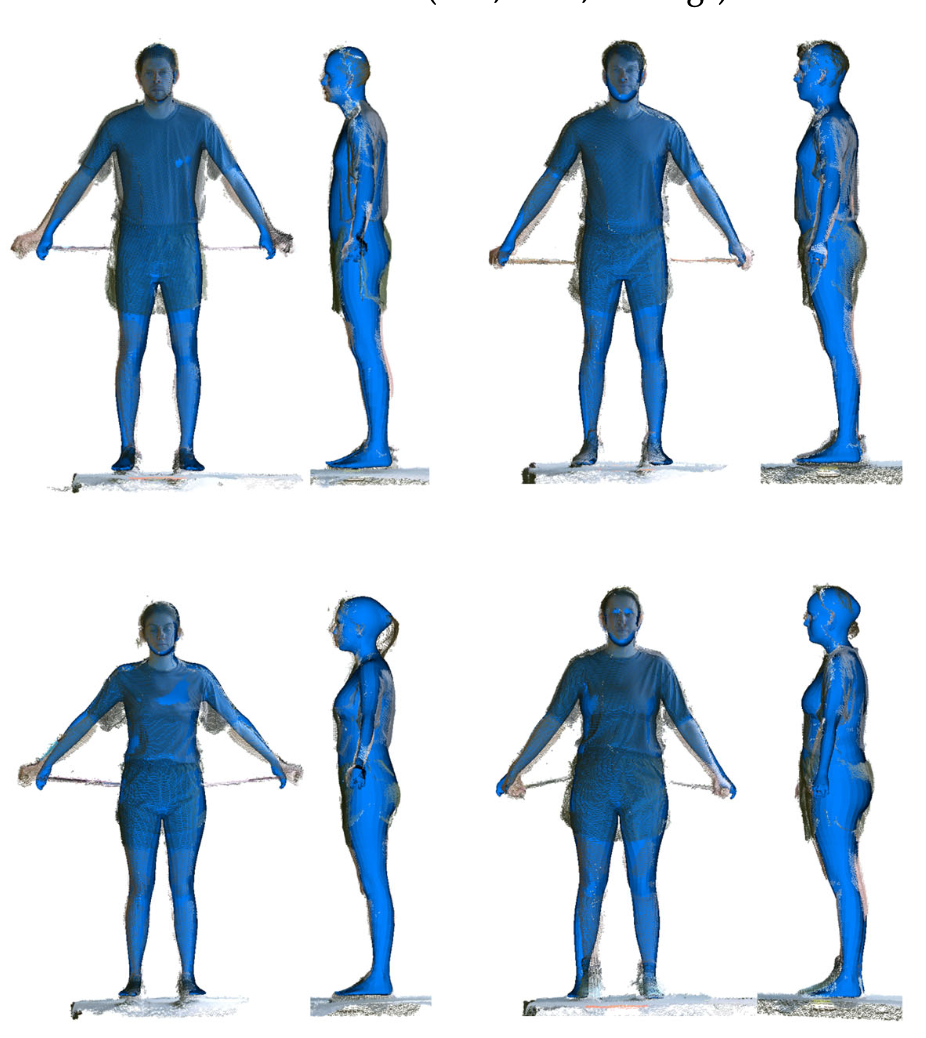
My colleague Dr. Daniel Park has been leading work on our fast, efficient PassFit human measurement system. We recently published a paper in Sensors documenting the performance of an early version of the system for estimating body dimensions of clothed individuals in a fraction of a second. (The current system is far more advanced -- these data were gathered over 5 years ago.) We have enjoyed strong support from the U.S. Department of Defense for the development of the system, due to their need for repeatable and reproducible human measurement with minimal operator training. We're currently supporting a pilot deployment of PassFit for the U.S. Air Force, focused on issuing of clothing and equipment. Near term plans include deploying the systems to recruiting stations so that prospective servicemembers can immediately know which planes they'll be eligible to fly.
Update: 2024-10
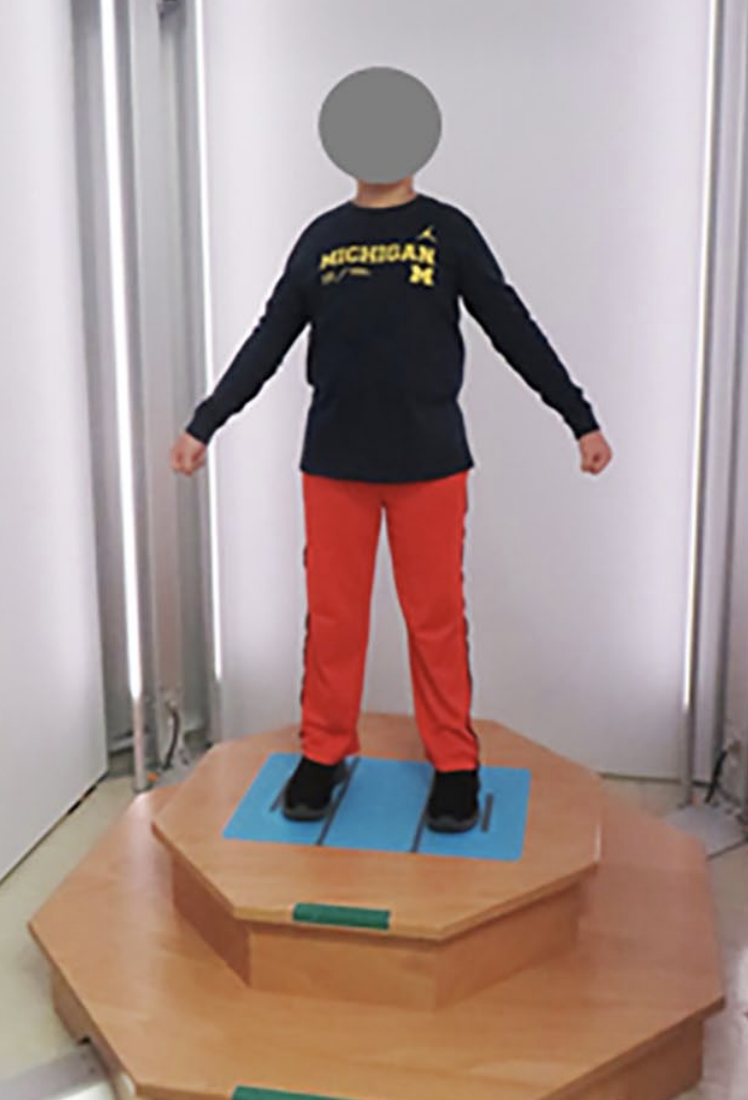
My colleague Dr. Monica Jones presented a paper at the annual conference of the Human Factors and Ergonomics Society describing the methods for our YouthShape.US survey. As of Fall 2024, we have gathered very detailed body size, shape, strength, and physical activity data from over 650 children and adolescents ages 3 to 17 years. This extremely rich dataset includes over 50 manual anthrometry measures, high-resolution 3d surface scans of the head, hands, feet, and whole body dozens of postures, as well as grip strength, lower extremity power, body composition, and many other measures. This dataset is already the richest child anthropometry dataset in the world, and yet is only the pilot study for what will be a study of over 4000 children and youth by the end of 2026.
Update: 2024-08
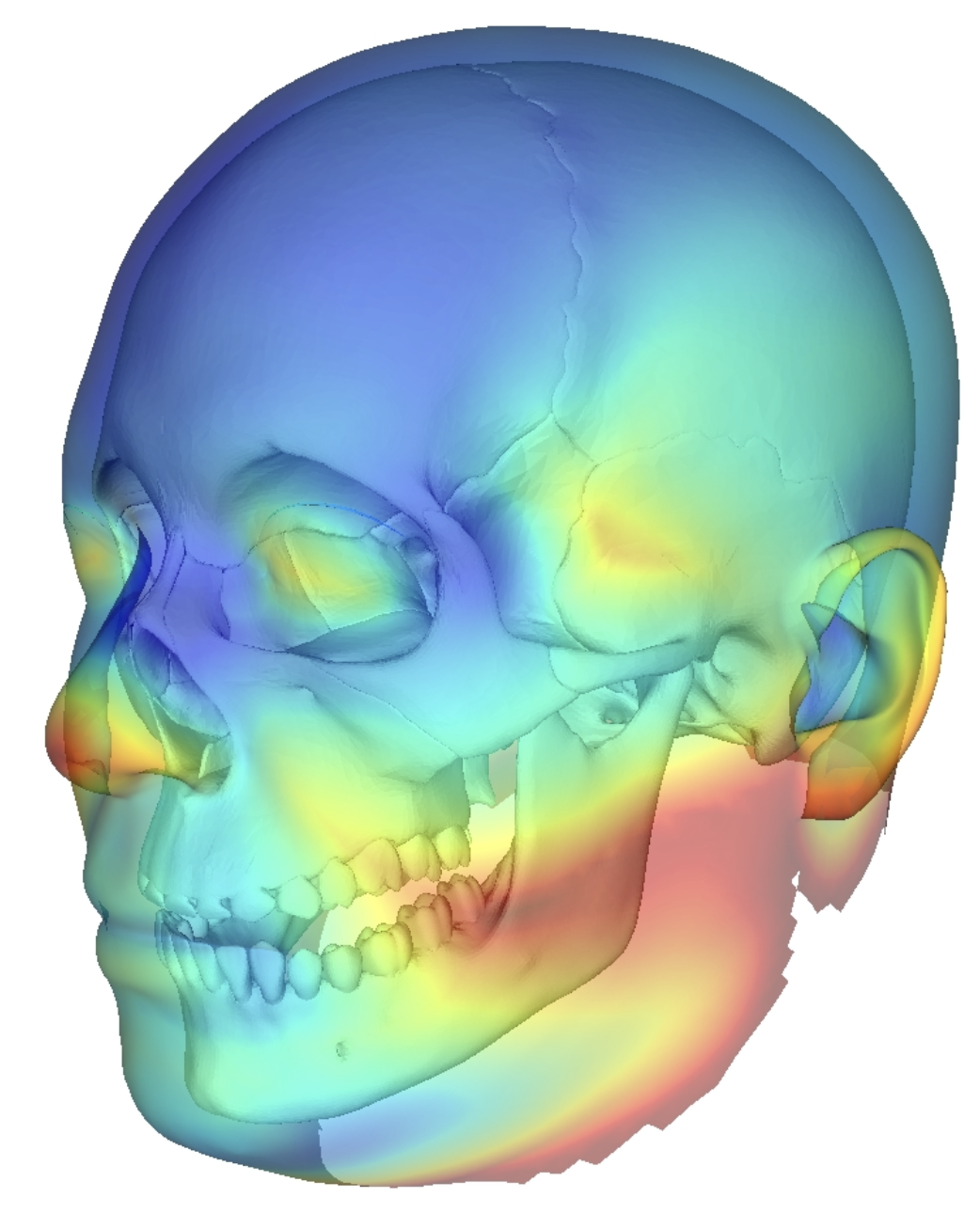
We continue to make progress on many areas of our research, including our YouthShape anthropometry survey of children ages 3-17 years (now over 550 children measured in 3D), child strength measurements (data over 800 children ages 9 months to 11 years now being analyzed), and statistical modeling of anatomical structures, including the spine, ribcage and head. The image to the right shows our new skull model. Based on 244 high-resolution CT studies (each extracted skull is over 1.5M polygons), the new parametric skull model allows us to predict with high accuracy the skull inside any head surface scan. Or vice-versa: we can predict head/face shape from the skull, a goal of many forensic analyses. Our primary application is generating a wide range of realistic heads to analyze things like oxygen mask fit for fighter pilots (a current project), VR headset fit (another current project), and concussion risk as a function of head and neck geometry. [In the image, the color scale reflects the flesh margin between the skin and the nearest point on the bone. The model accurately predicts the very thin flesh margins at the bridge of the nose and around the orbit.]
Update: 2024-03
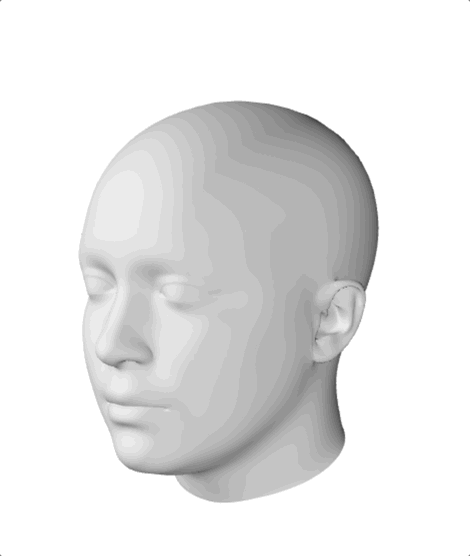
Our colleagues at SENTIR Research Labs in Dayton hosted the inaugural Biomechanics and Engineering Anthropometry Meeting (BEAM) this month. This three-day event included dozens of speakers from U.S. DOD, contractors, and other researchers who work on human safety and accommodation. My colleague Dr. Daniel Park presented an update on our PassFit portable anthropometry system that enables rapid prediction of body dimensions under normal clothing. I showed our progress integrating our detailed adult ear geometry model with a new head surface model based on hundreds of surface and CT scans. The new model provides unprecedented accuracy and detail in capturing the size and shape variability in the U.S. population. In addition to our core biomechanics and safety applications, the model will be valuable for the design of helmets and masks as well as audio products, including in-ear and over-ear headphones, hearing protection, and personalization of the head-related transfer functions (HRTF) essential to realistic spatial audio. We will be continuing this work in the coming weeks, adding data from hundreds of additional subjects. Future work will include integrating a parametric skull model, so that we can predict the skull from the surface or add a realistic surface to a skull.
Update: 2024-01
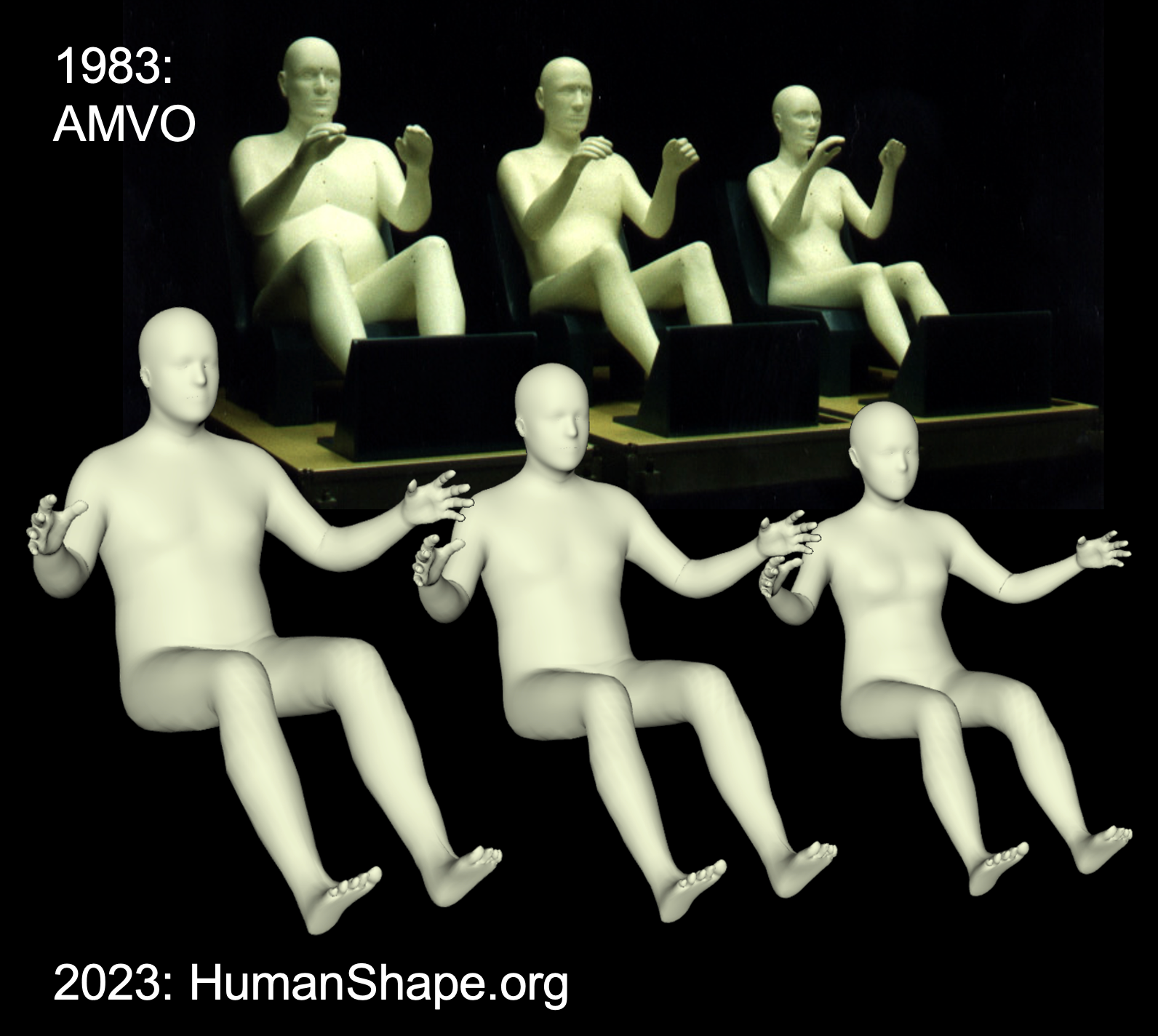
At the SAE Government/Industry meeting this month I had the opportunity to give an overview of our occupant anthropometry research, including a preview of the work we'll be doing for NHTSA over the next few years. In the early 1980s, UMTRI led the first ever large-scale, detailed, 3D study of occupant anthropometry. NHTSA funded the Anthropometry of Motor Vehicle Occupants (AMVO) study to generate anthropometric specifications for a new generation of crash test dummies. These data have been the basis for almost all adult dummies developed since that time, including the THOR and WorldSID families. Given changes in the population and dramatic improvements in measurement methodology, we're now doing "AMVO for the 21st Century". We'll be focusing on female and high-BMI occupants, since these populations have been underrepresented in AMVO and other early datasets, but we're developing open tools similar to HumanShape.org that will include accurate body surface and skeletal geometry for both male and female occupant . We expect to have results based on our existing data by this time in 2025 and results based on new data by 2026.
Update: 2023-11
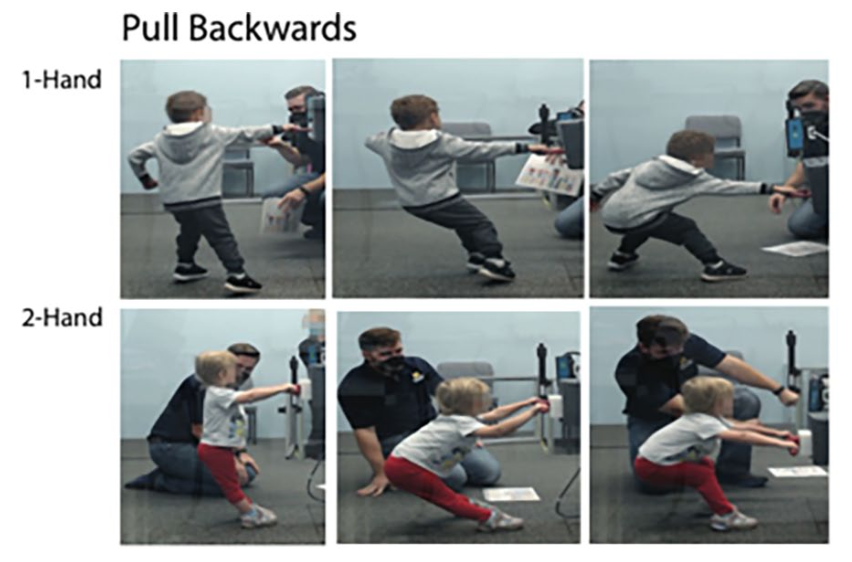
Last month at the HFES annual meeting, Dr. Monica Jones presented an overview of our methods for gathering data on child strength. In the past year we have gathered functional strength data from over 500 children with ages from six months to five years. Strength is challenging to measure for adults, but for children different methods are needed that depend on the level of motor and cognitive development. Dr. Jones and Sheila Ebert worked with developmental psychologists, pediatricians and other experts to develop novel methods. This work was funded by the U.S. Consumer Product Safety Commission and will provide valuable new information to inform the design of safe products.
Update: 2023-06
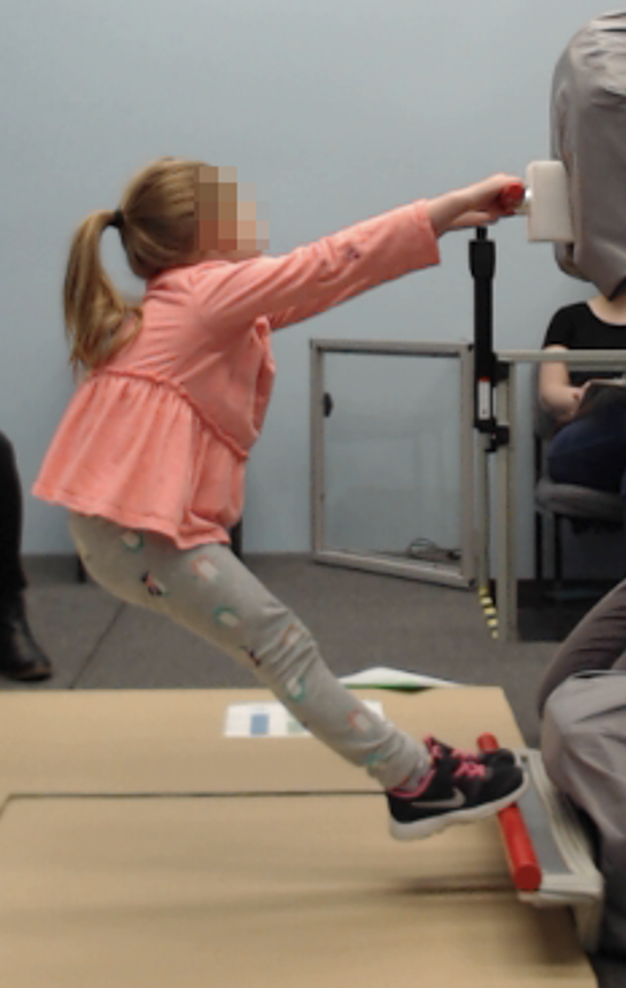
We have been exceptionally busy even by our normally crazy standards. But we're fortunate to be able to do studies that will have major impact in future years.
Children Climbing on Dressers (Clothing Storage Units): Tip-Over Injuries
Thousands of young children every year in the U.S. are injured when a dresser they are interacting with (usually climbing on them) tips over. Beginning in 2019, the U.S. Consumer Product Safety Commission funded a study in our group to quantify, for the first time, the forces children exert when climbing. We designed a laboratory study and recorded force and posture data for 40 children ages 2 to 6 interacting with our lab fixtures in various naturalistic ways. The results of the study were cited in the development of a new regulation for clothing storage units that the CPSC issued in the fall of 2022. As these things go, the industry sued and lobbied Congress to force CPSC to instead adopt a much weaker, industry written ASTM standard. But the overall story is still a success: clothing storage units (dressers) will be safer under the new mandatory standard than under the earlier voluntary standard. Moreover, our research highlights the reality that children can easily exert forces on furniture that greatly exceed the values in the standard. Our report on this work appeared in the Federal Register in 2022 and is now available at U-M.
Ear Geometry Modeling for Audo and Other Applications
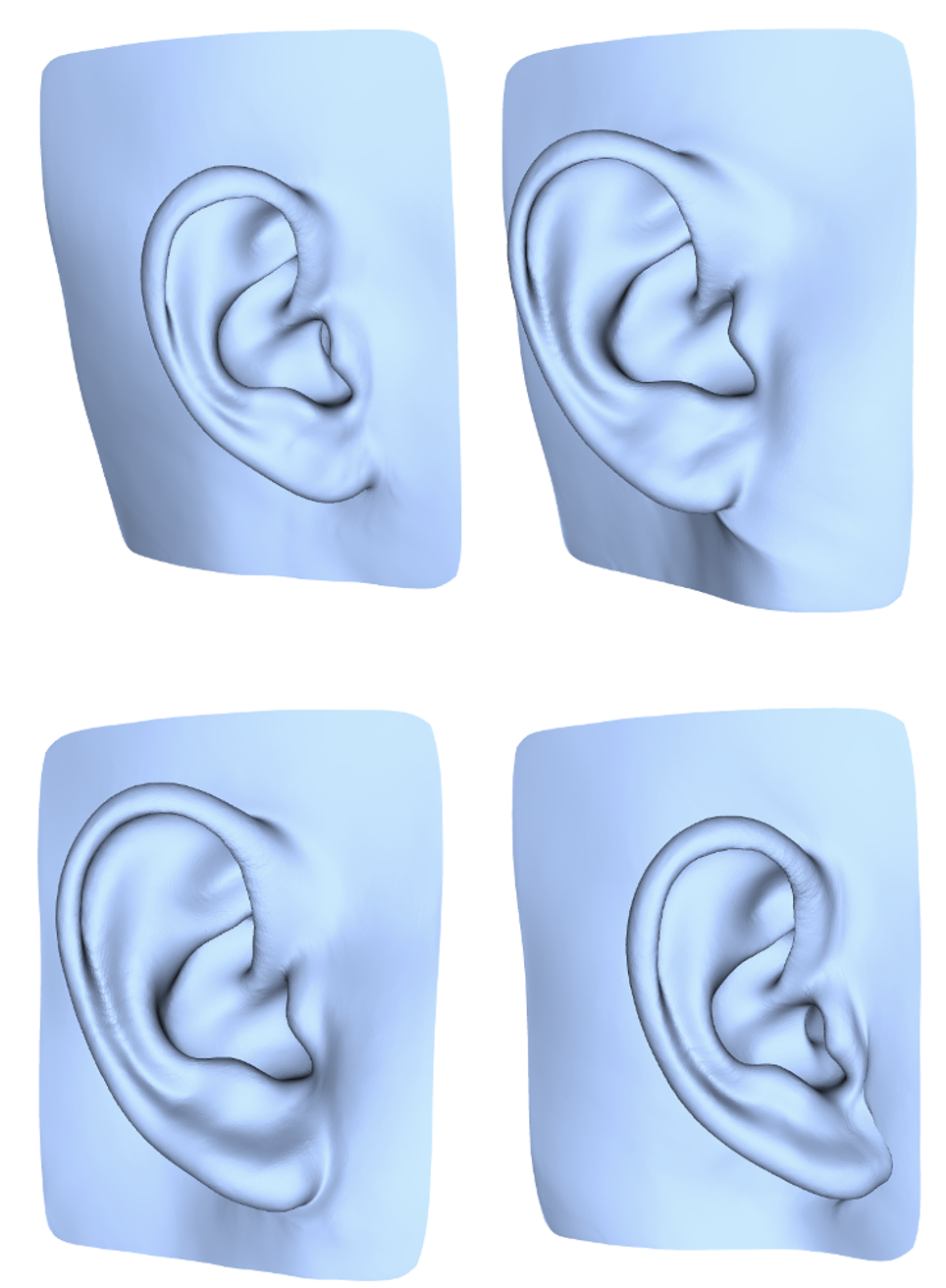
The technical report on our recent ear geometry modeling effort is now available online. Prior studies have used primarily landmark-to-landmark measurements rather than a three-dimensional analysis. We extracted 331 ears from CT studies of 224 people and developed a high-resolution statistical shape model capable of highly expressive representation of a wide range of ear size, shape, and location. Principal component analysis demonstrated a large amount of variance not previously quantified in the position and orientation of the ears with respect to the skull. A regression analysis confirmed previous findings of sex differences in the increase of ear size with increasing age and demonstrated an effect of body mass index on ear position and orientation that has not been previously described. A boundary method in principal component space was used to generate a set of ears suitable for designing devices for which the ear position on the head is important. Boundary ears were also generated in pinna-centered coordinates for applicability to in-ear device design, demonstrating the flexibility of the dataset and analysis methodology. To our knowledge, this study developed the largest and highest-resolution database of human ear geometry, the first to be measured in head-centered coordinates, and the first to include the geometry of the canal to the ear drum.
Update: 2023-01
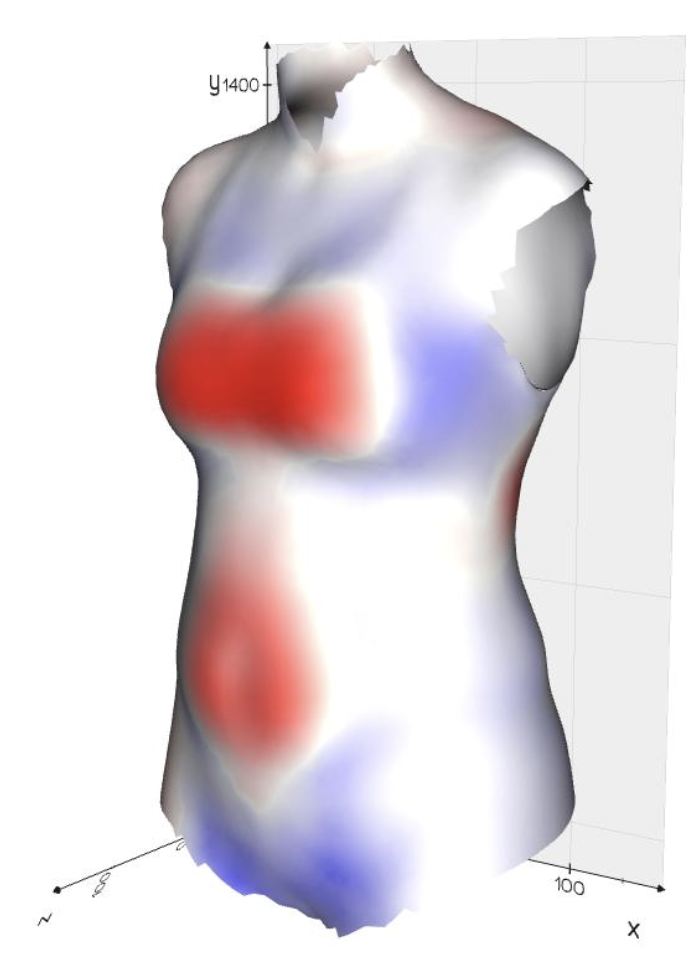
A few updates on some of many projects my colleagues and I are currently working on:
Female Body Armor Fit
We're wrapping up a study for the U.S. Army Natick Soldier Center looking at issues related to body armor for female warfighters. In spite of a couple of decades (at least) of attention to the issue, complaints from the field indicate that body armor systems still don't work well for some women. In reviewing the literature, we found that minimal knowledge was available on the basics of the interaction between the torso and the body armor, so we focused our attention on developing methods to quantify that. This Phase-1 project included a laboratory study using 3D laser scanning and careful posture control to create the first-ever statistical model of torso deformation under body armor. We also developed a parametric finite-element modeling framework capable of simulating torso/plate interactions accurately.
Ear Geometry Modeling
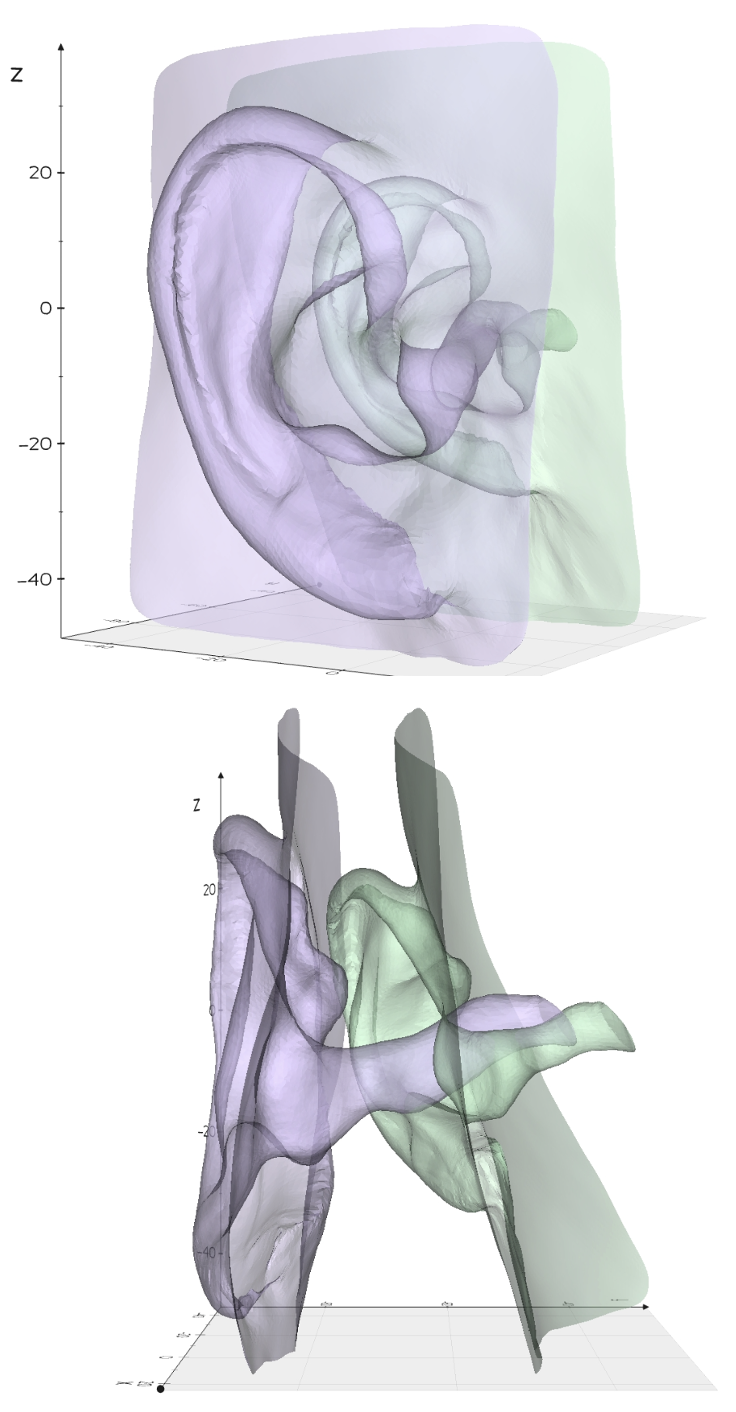
The shape of the human ear is of increased interest due to the importance of spatial audio for virtual reality applications. A person's ear and head shapes alter the way the sound reaches the ear drum on each side of the head, enabling people to very accurately locate the direction and distance of sounds. The head-related transfer function (HRTF) or equivalently the Head-Related Impulse Response (HRIR) describe quantitatively the ways that a particular person's anatomy affects the sounds reaching their eardrums. Knowledge of a each person's anatomy is needed to provide them accurate spatial audio through binaural headphones. Prior work on quantifying the variability in human ear shapes has focused primarily on point-to-point dimensions on the pinna (external ear) and to a lesser extent on outer ear canal geometry based on molding techniques that have been used for decades to create custom hearing aids and other in-ear devices. Drawing on our expertise in medical imaging data, we have created a new best-in-class model of ear geometry that incorporates the head, scalp, pinna, as well as the entire ear canal to the ear drum. The new model, based on data from hundreds of people, will provide an unprecedented ability to design audio experiences for the entire spectrum of head and ear shapes. We hope to integrate the new ear model into our head model to create new audio design tools.
Update: 2022-11
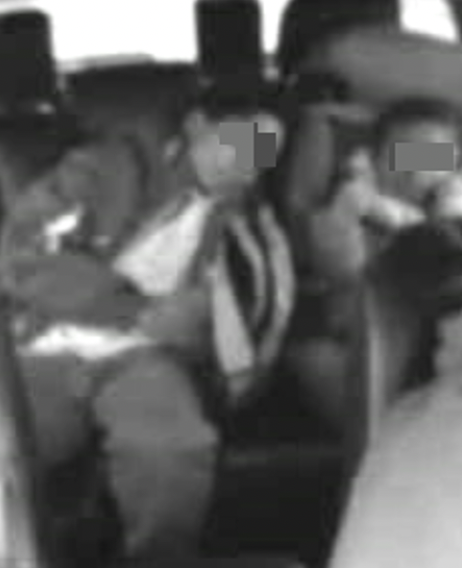
Last year, my colleagues and I published the first large-scale naturalistic study of front-seat passenger postures and behaviors using a vehicle interior camera. Although it was not the focus of the study, the video also included views of the rear seat passengers. We coded the video using the same techniques we'd applied to the front seat and were able to describe some interesting aspects of rear occupancy and behaviors. One of the more notable findings was a dramatically lower second-row belt use rate in two ride-hailing (Uber) vehicles that were included in the study. This has concerning implications for potential future mobility if ride-hailing begins to account for a larger proportion of trip. This paper was presented at the AAAM annual meeting and i Traffic Injury Prevention.
Update: 2022-10
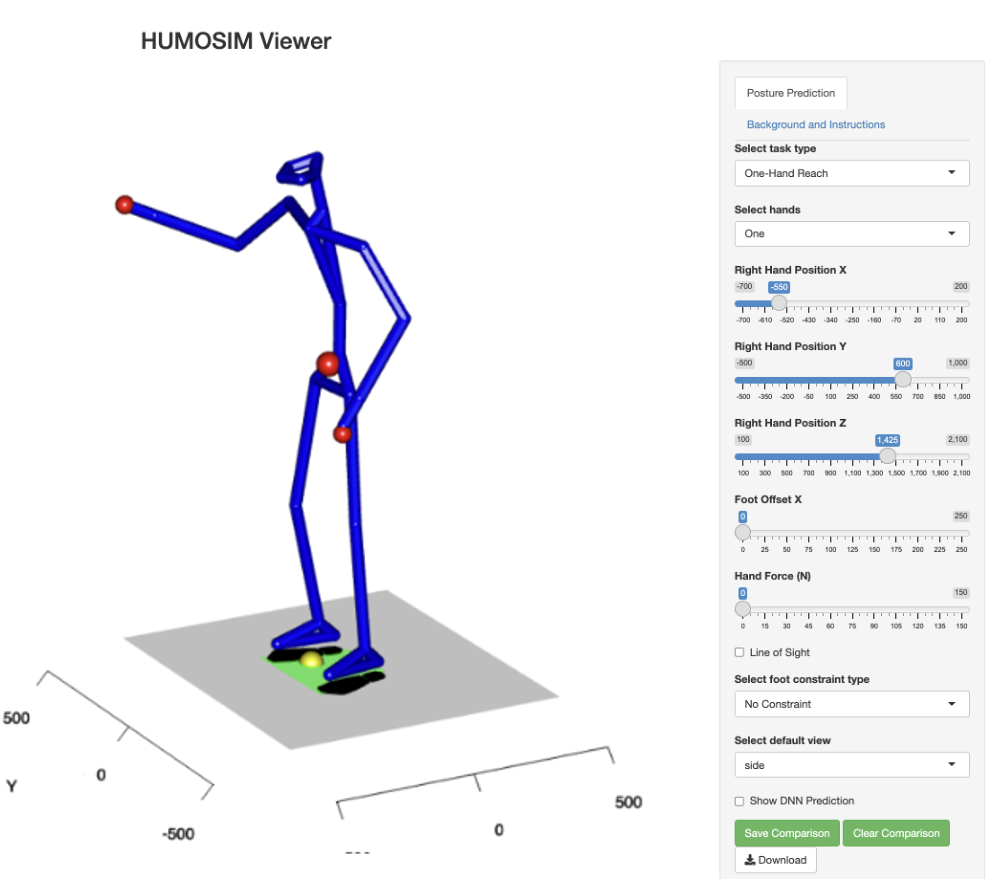
At the Human Factors and Ergonomics Society annual meeting this month, I presented a paper in an occupational ergonomics sesssion on some playing around I've been doing with machine learning and large posture datasets. This paper gives an overview of a deep neural net regression model that predicts standing task postures from anthropometry and task parameters (hand locations with respect to the feet, hand forces, and a few other variables). The data were gathered in two large-scale studies led by my colleagues Dr. Monica Jones and Dr. Clive D'Souza. The DNN models were fit in R using the Keras library. What's more interesting is that I have created an online demo with downloadable output. The demo was written in R using Shiny. The implementation of a prediction model like this in human modeling software used for ergonomics analysis is critical, because the predictions are never quite consistent with the physical requirements of the task. The Humosim Framework approach uses inverse kinematics and optimization to match the predictions as well as possible while also respecting the kinematics constraints and maintaining balance. This proof-of-concept could lead to more useful implementations, in part through incorporation of more data. The extension to motion is straightforward; we have 10s of thousands of motions in our database that could be used for training.
Update: 2022-09
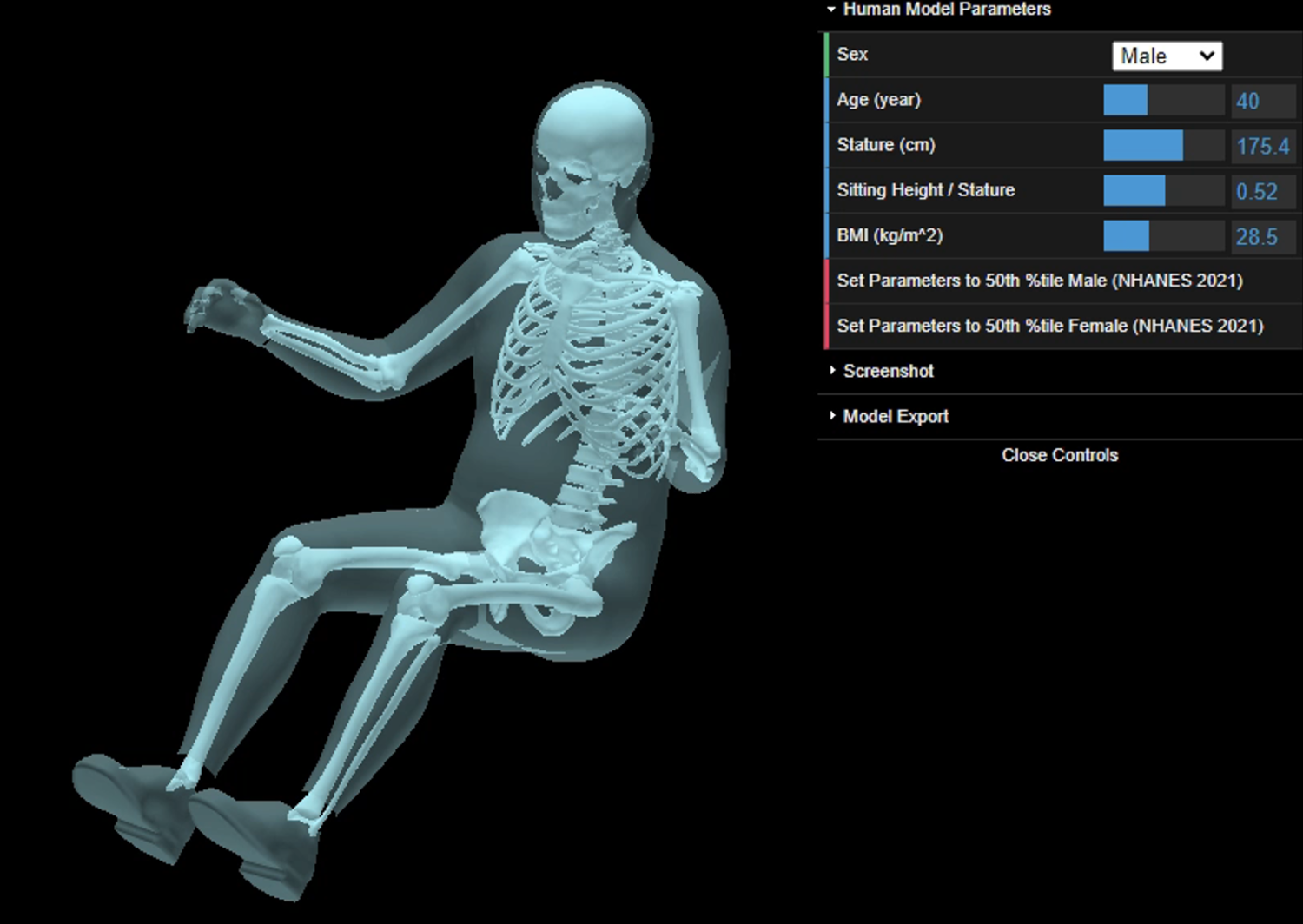
The IRCOBI conference in Porto marked our first public presentation of the new Hermes™ finite-element human body model developed in our group. Led by Dr. Jingwen Hu, a large team has been working for over a decade to develop a rigorous research foundation for a fully parametric, efficient FE model for population-based optimization of safety systems. Conventional FE human body models are too complex and hence too slow to use for large-scale optimizations, but Hermes runs approximately 4x as fast as the "fast" models currently in use. We achieve this by using a carefully constructed mesh designed from the start to be morphable to nearly any adult body size and shap. An interactive representation of the Hermes™ geometry is now available online. A downloadable version will be available soon.
Update: 2022-09
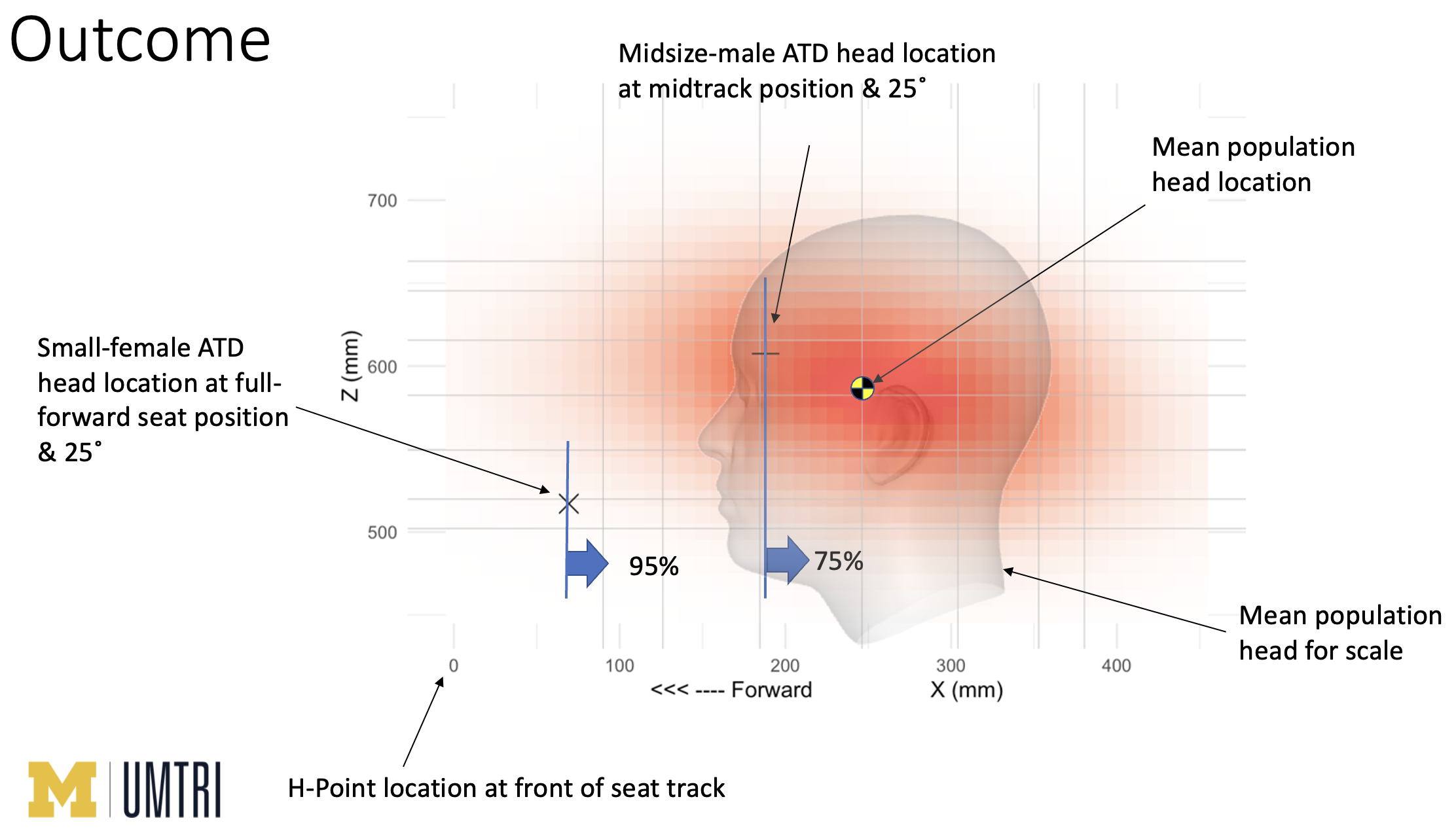
At the annual IRCOBI conference in Porto, I presented two short communications based on our work in the Biosciences group. Using data from two previous studies, I presented a statistical model of front-passenger head location. A large amount of work from our lab and others has quantified driver head location, and to a lesser extent head locations in second-row, fixed seats, but no prior studies have presented empirical data on front passenger head location. I combined seat position and seat back angle data from a recent naturalistic study conducted in 75 vehicles with volunteer data from a lab study. For this injury biomechanics conference, I compared the head locations of the ATDs used in crash testing with the actual passenger head locations (in nominal postures). Of course, we've previously documented the large range of non-nominal postures and the effects of abrupt vehicle maneuvers on passenger postures. The range of likely pre-crash passenger postures is much larger than the range used in regulatory and consumer information testing.
Update: 2022-08
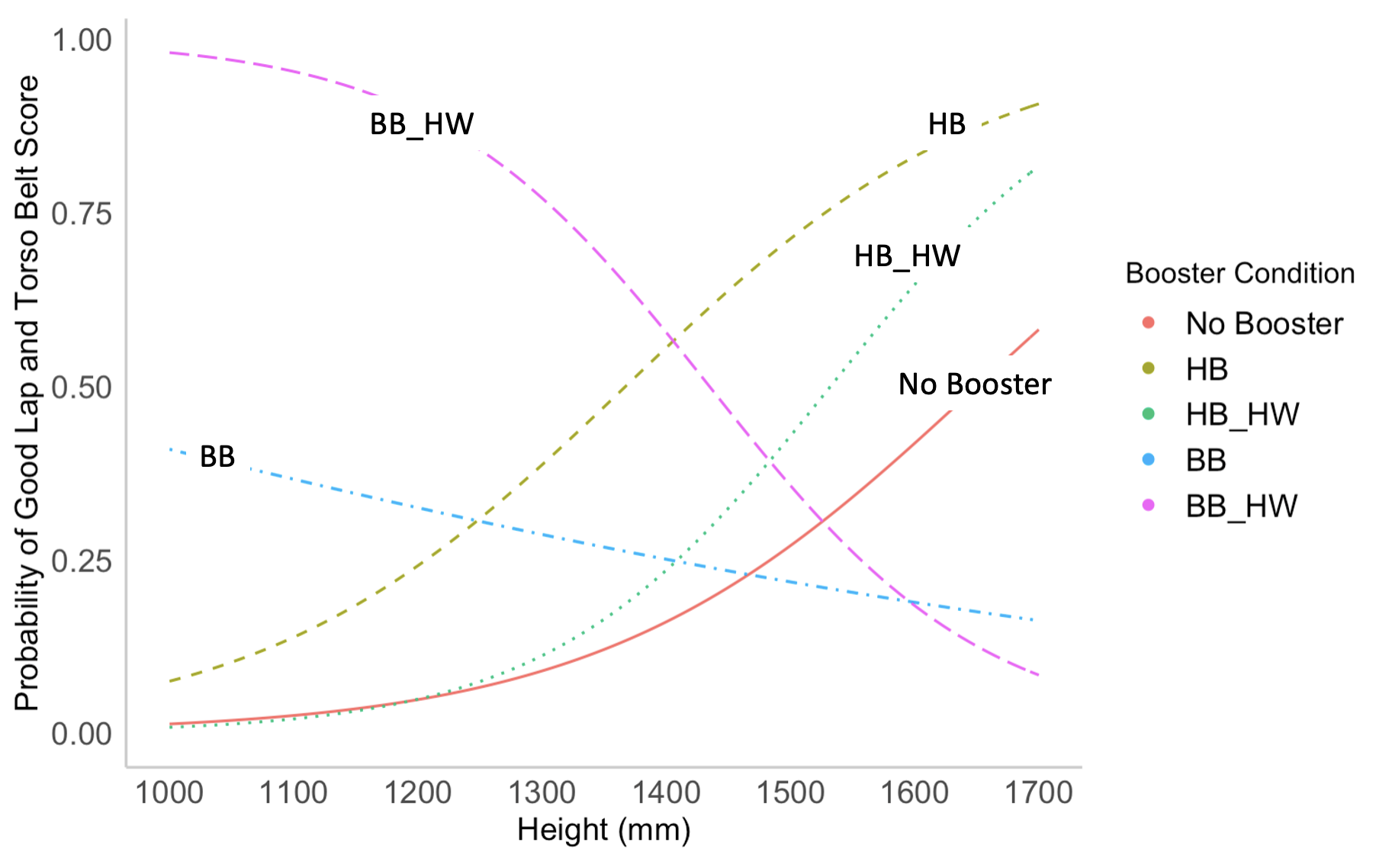
We haven't been doing as much child passenger safety research as we did from 2005 to 2015, but we recently collaborated with CDC and Westat on a study of child posture and belt fit in second row seats. Our role was in training the study team and analyzing the results. The study, published in Traffic Injury Prevention, is similar to some of our previous work, but used a more diverse population of children. As we have demonstrated previously, being a certain stature (say, 4'9") does not guarantee a child good belt fit. Instead, belt fit must be assessed individually. We are cautiously optimistic that new dynamic consumer information testing with a small female ATD in second-row seats will improve belt geometry, benefiting all occupants in those seats.
Update: 2022-06
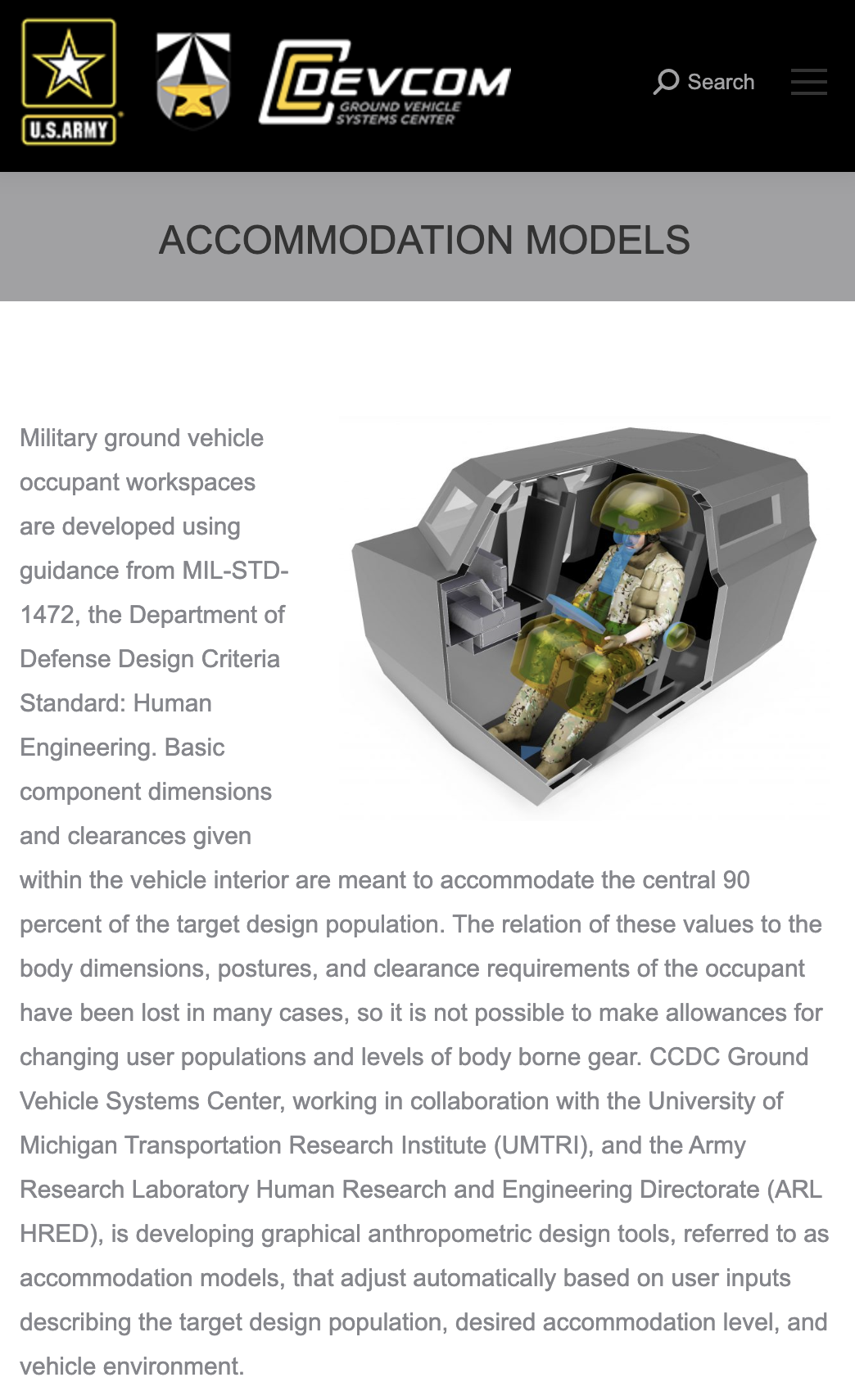
I'm very proud of the research program that we're leading for the U.S. Army that is creating a modern suite of tools for human-centered design of vehicle interiors. Now in its 10th year, this program has been funded by the Army's Ground Vehicle Systems Center (formerly TARDEC). Through the program, we have measured posture and position of over 1000 people, including over 750 soldiers, in a wide range of vehicle seating conditions. Using statistical models we created from the data, our collaborators in the Army have developed a suite of CAD tools that enable vehicle designers to readily account for the distribution of body size in the Army, taking into account the effects of body armor and body borne gear. This is a radically new paradigm for military vehicles, which have typically been developed using the 1950s-style guidance in MIL-STD 1472. With this program, U.S. military vehicles now have a more advanced suite of human-centered design tools than any other vehicle category, including road, agriculture, and construction vehicles. This new approach offers considerable potential for these other domains as well.
As the design tools pass the Army's verification and validation process, they are published online for all to use. See examples: Soldier Accommodation Models
Update: 2021-10
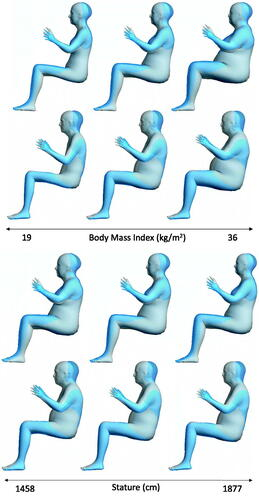
Our 3D anthropometry team, including my colleages Dr. Daniel Park and Dr. Monica Jones, have published the first whole-body parametric human body model for supported seated postures. This is also the first published body shape model for seated postures to include a rigorously derived effect of age. Since nearly all design applications in seating involve backrest support, this closes a large gap in the literature. This stream of research goes back 20 years, to early modeling using the CAESAR dataset. Our first model for seat and chair design was published in 2008, but that model was limited to the torso area. The recently published model was developed about 2016, but it took us a few years to get around to reporting it in the journal literature. Meanwhile, our group has made extensive use of seated body shape modeling in parametric human body modeling. A related model has been available at HumanShape.org for a few years. An additional publication is in the works that demonstrates parametric posture change driven by validated posture-prediction models.
For more on our body shape models, check http://HumanShape.org/
Update: 2021-09
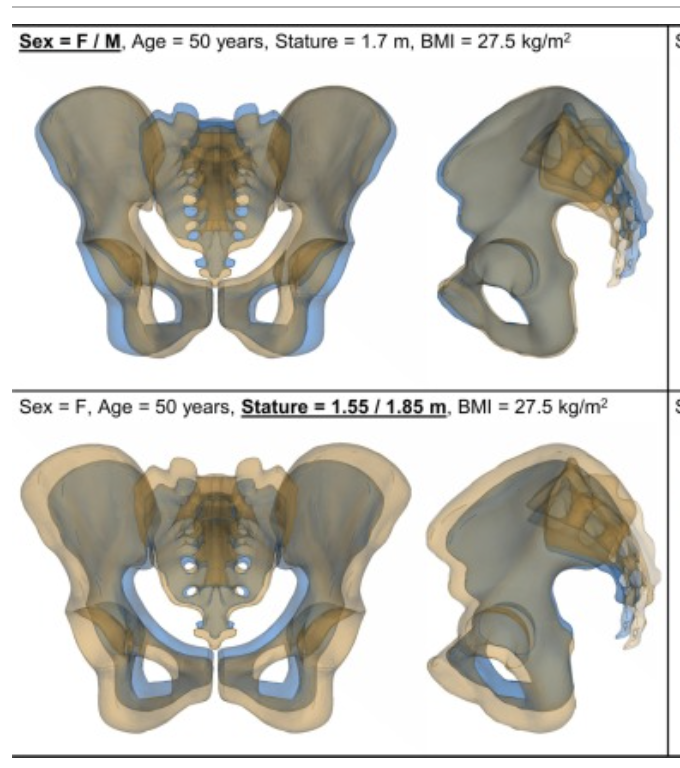
Erik Brynskog, a PhD student at Chalmers University in Sweden, has just published what is currently the best-available statistical model of pevis geometry. Using a dataset of geometry extracted from CT studies that was originally developed by Katelyn Klein and other UMTRI researchers, Erik digitized a much larger landmark set, enabling a considerably higher-resolution model of the pelvis. He also used a sparse PCA method in place of the conventional PCA, which will allow him to study local variability in pelvis shape more directly. Expect to see much more from Erik as he publishes the local shape analysis and considers how pelvis variability may affect restraint interaction and injury risk.
Update: 2021-06
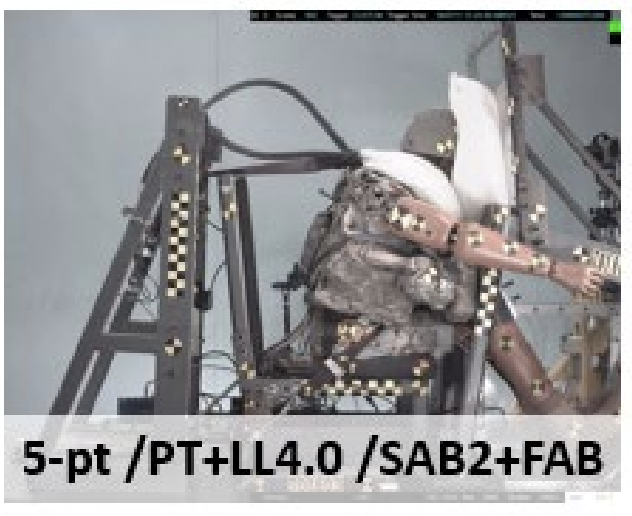
My colleagues Kyle Boyle, Nikki Orton, and Jingwen Hu recently published a paper describing new research aimed at improving crash protection for occupants of military ground vehicles. This is part of a long-running series of studies aimed at improving military vehicle design from a human-centered perspective, which has included contributions to new test dummy design, the development of a large range of vehicle interior design models based on occupant posture and space claim, and crash safety research including sled testing and full-vehicle testing.
Update: 2021-03
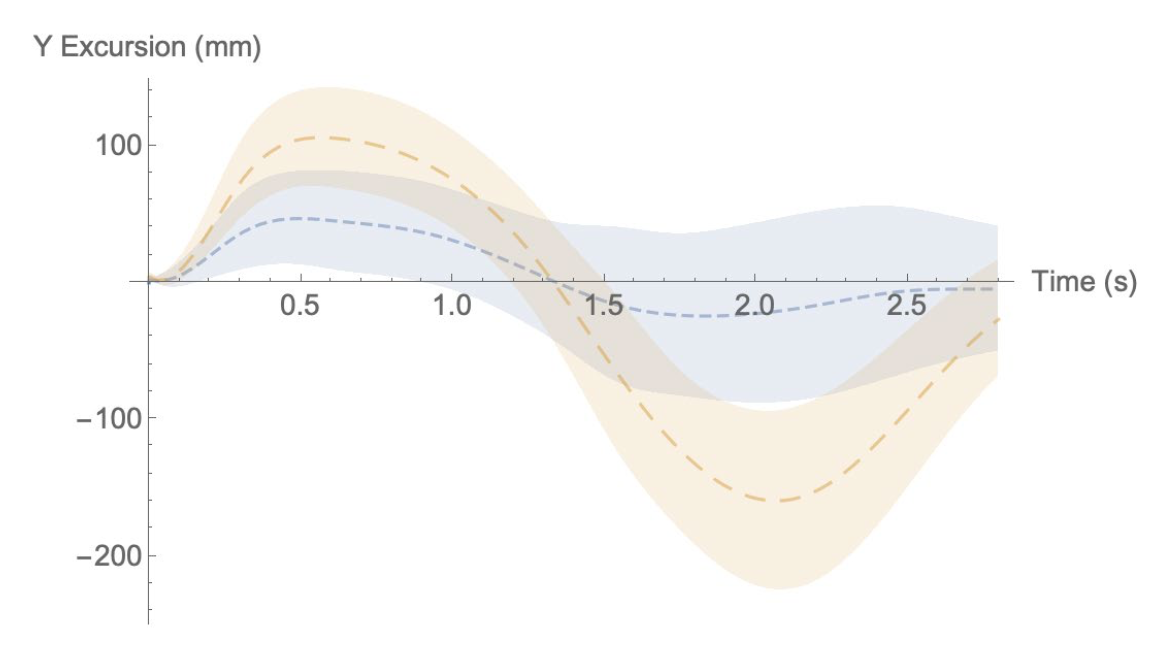
NHTSA has published our report on the effects of abrupt vehicle maneuvers on front-seat passengers with a wide range of initial postures. In the first part of the study, we tested 12 participants in three different vehicle models using the same protocols we'd used in an earlier study. We found differences in head exursion in one vehicle, but overall the results were similar. We then ran a large-scale, test-track study to examine the effects of initial posture on head kinematics in braking and lane-change maneuvers. The study with 90 participants documented the effects of recline, leaning forward, leaning inboard, and seat position. We used a functional regression approach to generate corridors for head excursions. To our knowledge, this is the first use of both a sample of this size and functional methods to quantify this important variability in pre-crash posture.
Update: 2021-01
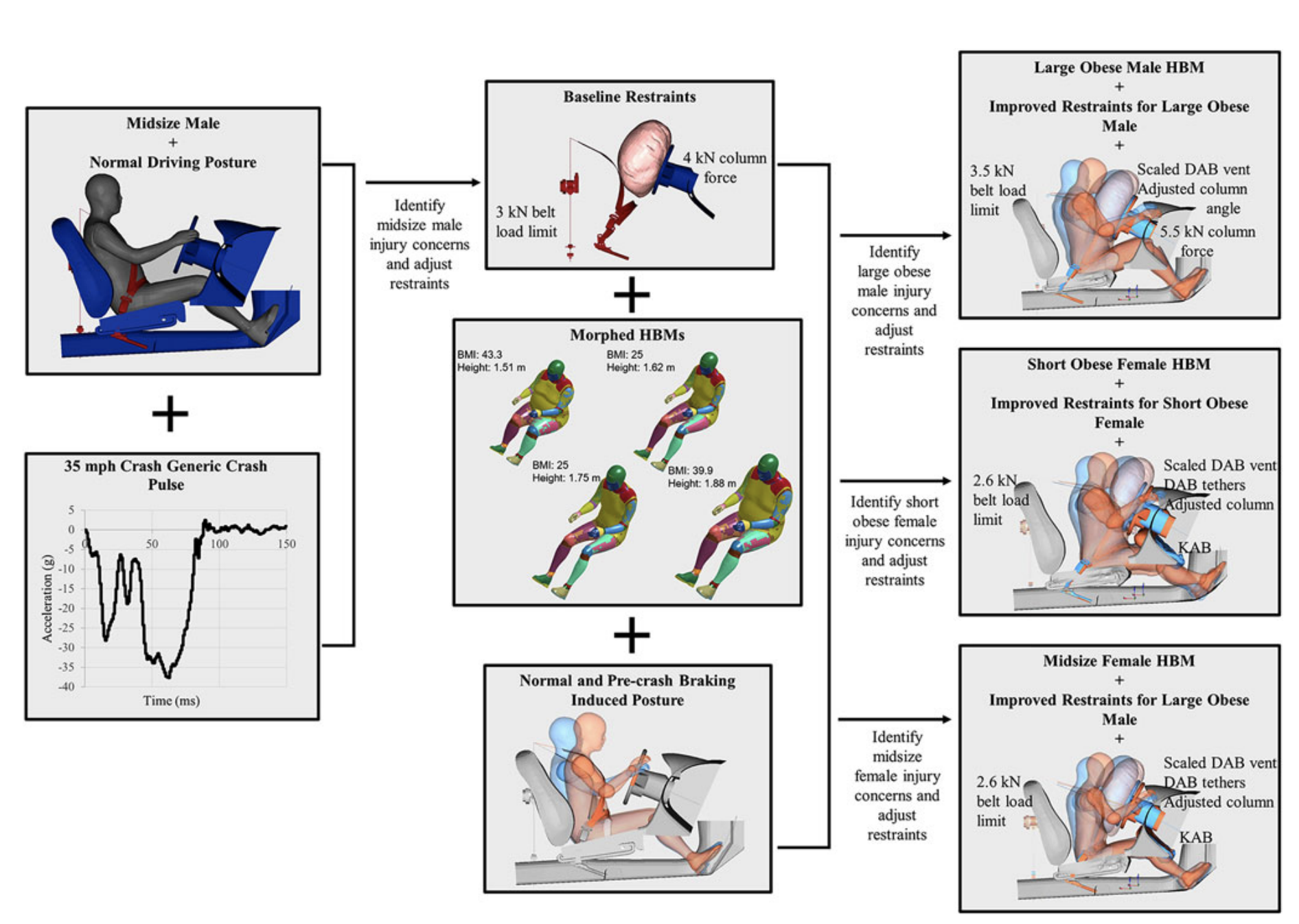
Our human modeling team, led by Dr. Jingwen Hu, published another paper documenting our application of parametric human body modeling to improving vehicle occupat restraint systems. This is the first analysis of the effects of pre-crash driving posture to take into account variability in both stature and BMI. It's also the first paper we're aware of to conduct human body model simulations with a midsize-female occupant. (Most prior work has used only a so-called "5th-percentile female" occupant that is very small for a driver in the US.) The simulation results demonstrated that body size and shape have larger influences on frontal crash outcomes than pre-crash posture over the ranges studied. The two obese models experienced higher levels of lower-extremity injury risk, consistent with results from the field. Now that more than 40% of US adults have BMI > 30, continuing to optimize restraints for crash test dummies that represent occupants with BMI < 25 is increasingly unrealistic. Parametric human body modeling allows a wide range of occupant sizes and shapes to be generated quickly so that restraint systems can be optimized for more realistic occupant populations.
Update: 2020-10
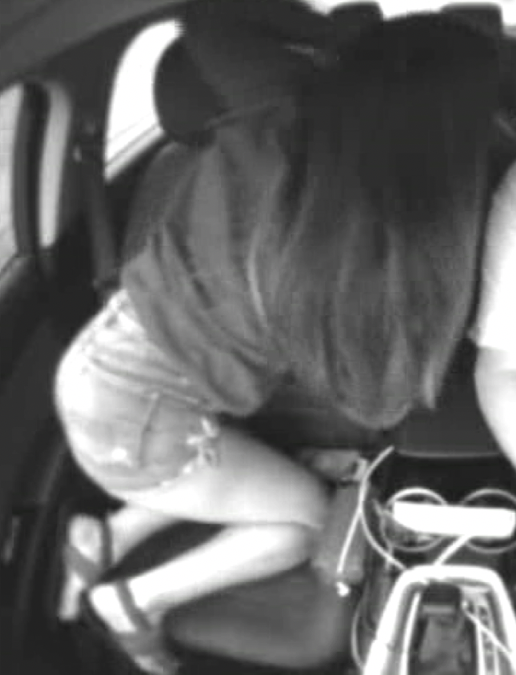
At the AAAM conference this month, I presented an overview of findings from the first large-scale study of road vehicle passenger behavior. This was an update on a presentation I gave at the 2020 SAE Government-Industry meeting. The AAAM presentation is based on a publication in Traffic Injury Prevention focused on non-nominal postures. Currently, most evaluation and optimization of restraint systems is performed using crash test dummies (or computational versions of these dummies) seated in nominal postures, usually in the middle seat position with a seat back angle between 23 and 25 degrees. We have previously shown that abrupt vehicle maneuvers can shift passengers out of nominal positions, but the current research shows that passengers are sitting with their torsos rotated or leaned left or right more than 20% of the time. Non-nominal head postures, particularly looking down, are even more common. Although highly reclined postures were rare, passengers usually sat toward the rear of the seat track regardless of body size. The safety implications of these findings will be explored in future research.
Update: 2020-09
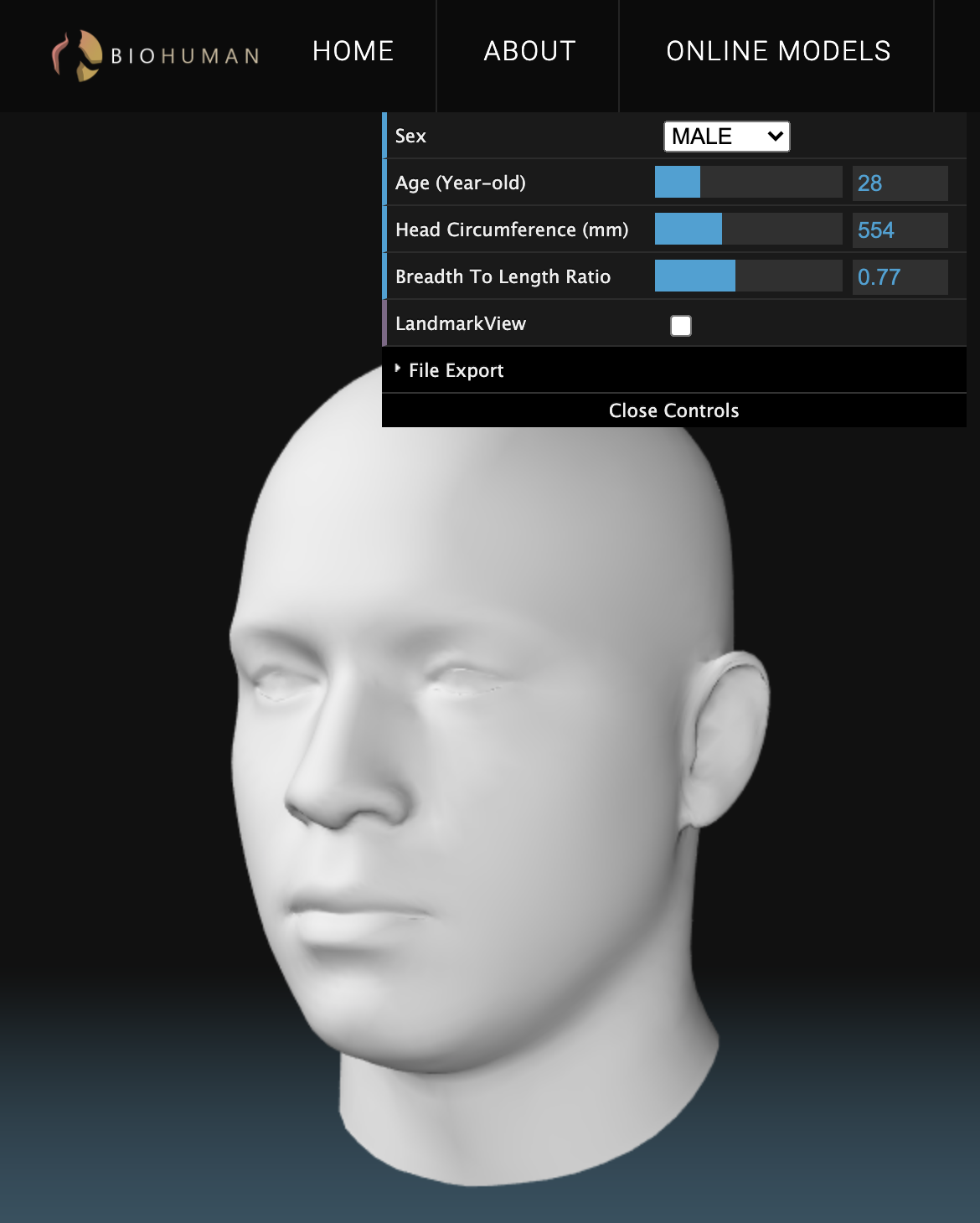
My colleague Dr. Daniel Park has just published a new head/face surface model that is one of only two we are aware of that includes a realistic scalp contour. Hair is a perennial problem in surface anthropometry studies. In most surveys, a wig cap or similar is used to compress the hair, but the resulting variable artifacts, which are typically larger for women. The resulting surface shapes are largely meaningless except for bald participants. Working with the US Air Force, we fit a template to data for 100 women obtained by a combination of head surface scanning and scalp point recording using a surface probe (FARO Arm). We added scans of 80 bald men to create a combined male/female statistical shape model. We have made a version of the new model available online at HumanShape.org. Users can vary head dimensions and download the resulting model. Importantly, the model includes a set of key landmarks defining facial features and skeletal points. The model has broad applications for the design of products that engage with the user's face and head, including protective helmets and masks as well as eyeglasses and other wearables. Contact us if you're interested in commercial applications.
Update: 2020-06
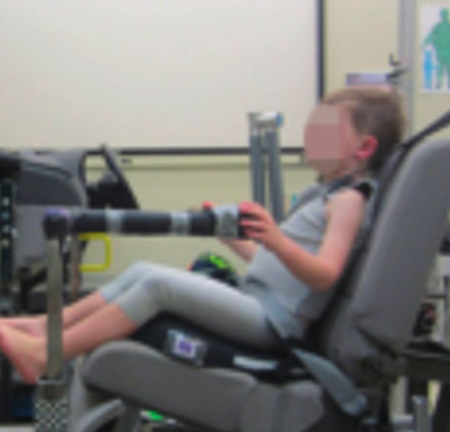
Our group has had a number of recent publications that I think are worth highlighting.
Jones, M.L.H., Ebert, S.M., Manary, M.A., Reed, M.P., and Klinich, K.D.K. (2020). Child Posture and Belt Fit in a Range of Booster Configurations. International Journal of Environmental Research and Public Health. 17(3):810.
My colleague Dr Monica Jones led this work, which builds on several previous studies in this domain. We have previously published extensively on posture and belt fit for booster-age children, including contributions to the development of the IIHS booster rating procedure that has resulted in substantial improvements in belt fit for children in boosters. This recent study was prompted by concerns that some recently developed "boosters that don't boost" could have adverse effects on child safety. In this study, we documented concerns about posture and belt fit with two of these new products.
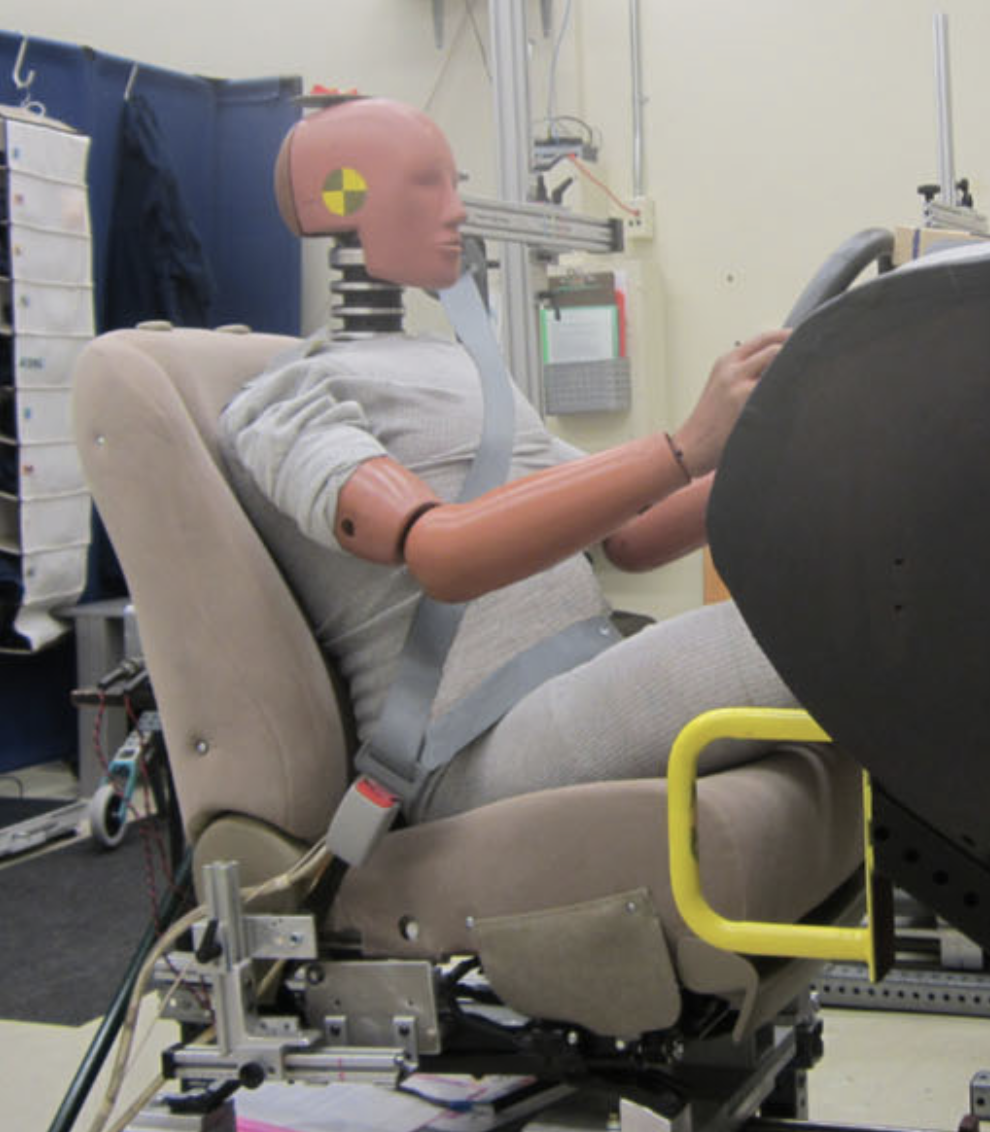
Park, J., Ebert, S.M., Reed, M.P., and Hallman, J.J. (2020). Comparison of Three-Point Belt Fit between Humans and Hybrid-III Anthropometric Test Devices in a Driver Mockup. Traffic Injury Prevention. 21(1): 98-101
A substantial stream of our work has focused on quantifying the important differences in restraint system interactions between humans and crash test dummies (ATDs). These differences are very important because restraint systems are optimized for ATDs, so that vehicles perform well on regulatory and consumer information tests that use ATDs. In this paper, my colleague Dr Jangwoon Park (now at Texas A&M) compared the belt fit obtained by midsize-male and small-female Hybrid-III ATDs with the belt fit for similar-size drivers. The lap belt fit is markedly better for the ATDs, meaning that humans experience the belt restraints in a less advantageous manner, on average. Improving restraint performance for humans requires integrating simulation results from parametric human body models that can represent the range of human body shape, belt fit, and posture better than ATDs can.
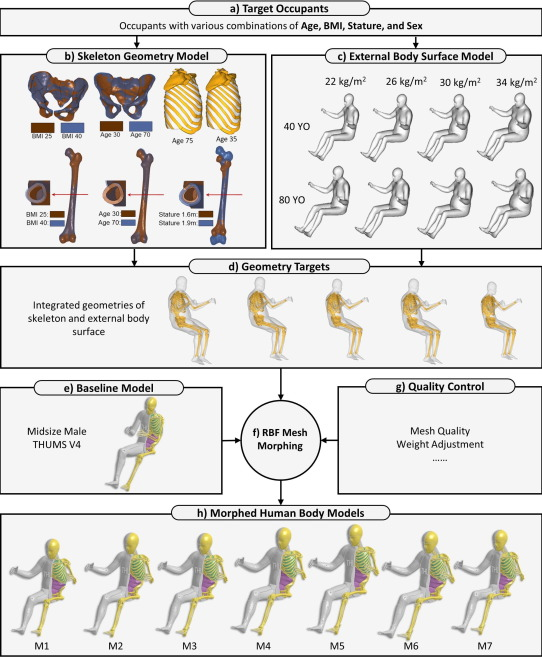
Hwang, E., Reed, M.P., and Hu, J. (2020). Validating Diverse Human Body Models against Side Impact Tests with Post-Mortem Human Subjects. Journal of Biomechanics. 98:109444.
This paper is one of series of studies examining the validity of parametric human body models (HBMs). As noted above, human models are needed to overcome the limitations of ATDs, which at best represent accurately a small percentage of individuals with low body mass index. Historically, HBMs have been constructed to be essentially identical in size to existing ATDs and then validated using the same ATD response corridors previously developed from post-mortem human subject data. Among the many problems with this approach is that the method is not readily applied to parametric HBMs that can be rapidly morphed to represent a large range of the population. Our team, led by Dr Jingwen Hu, has been developing a new approach to validation based on subject-specific comparison. One question addressed by this research is "how subject-specific" a model needs to be to represent PMHS data accurately. Is it sufficient to match stature and body weight, or is more detailed information about body shape, posture, and even tissue properties needed? Ultimately, much more PHMS data is needed from diverse populations that include sufficient imaging and posture measurements.
Update: 2020-01
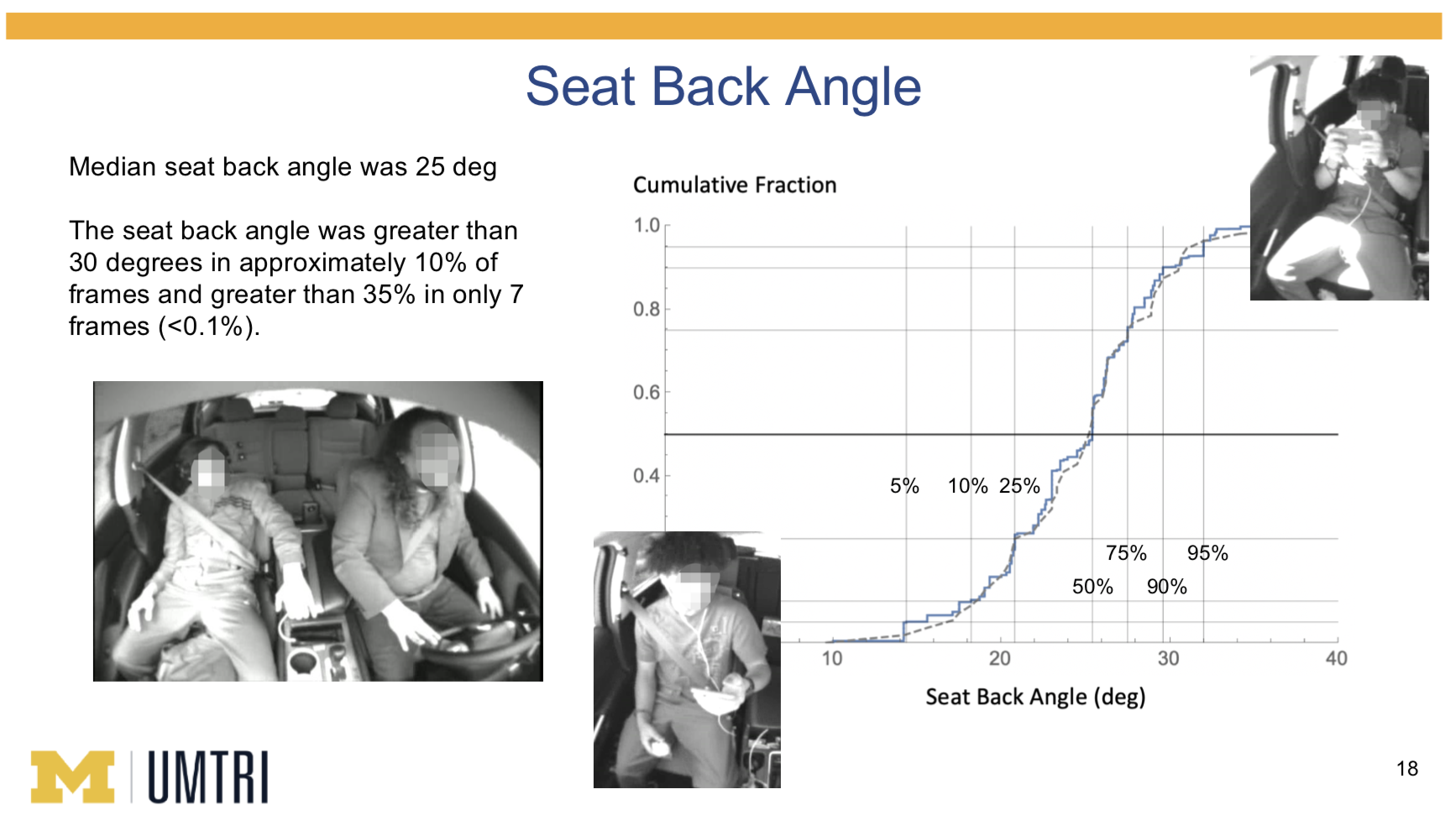
I gave a talk at the SAE Government/Industry meeting in DC this month highlighting preliminary results from a large-scale study of passenger behavior. In spite of widespread speculation in the industry and media about what passengers in future automated vehicles will do, very little published research focuses on adult passenger postures and activities. To address this gap, we recruited 75 people who regularly drive with passengers and instrumented the vehicles with interior cameras. I presented results from 57 of the vehicles. Among the interesting findings: talking and phone use are the most common front-seat passenger activities and resting (eyes closed) is relatively uncommon, only about 3% of the time. We also recorded seat position and seat back angle. We found that the front passenger seat was positioned full rear about 23% of the time, with the seat rearward of mid-track 81% of the time. We found no relationship between seat position and body size, unlike the case for drivers. We also found very few highly reclined postures. The seat back angle was greater than 35 degrees less than 1% of the time.
Update: 2019-11
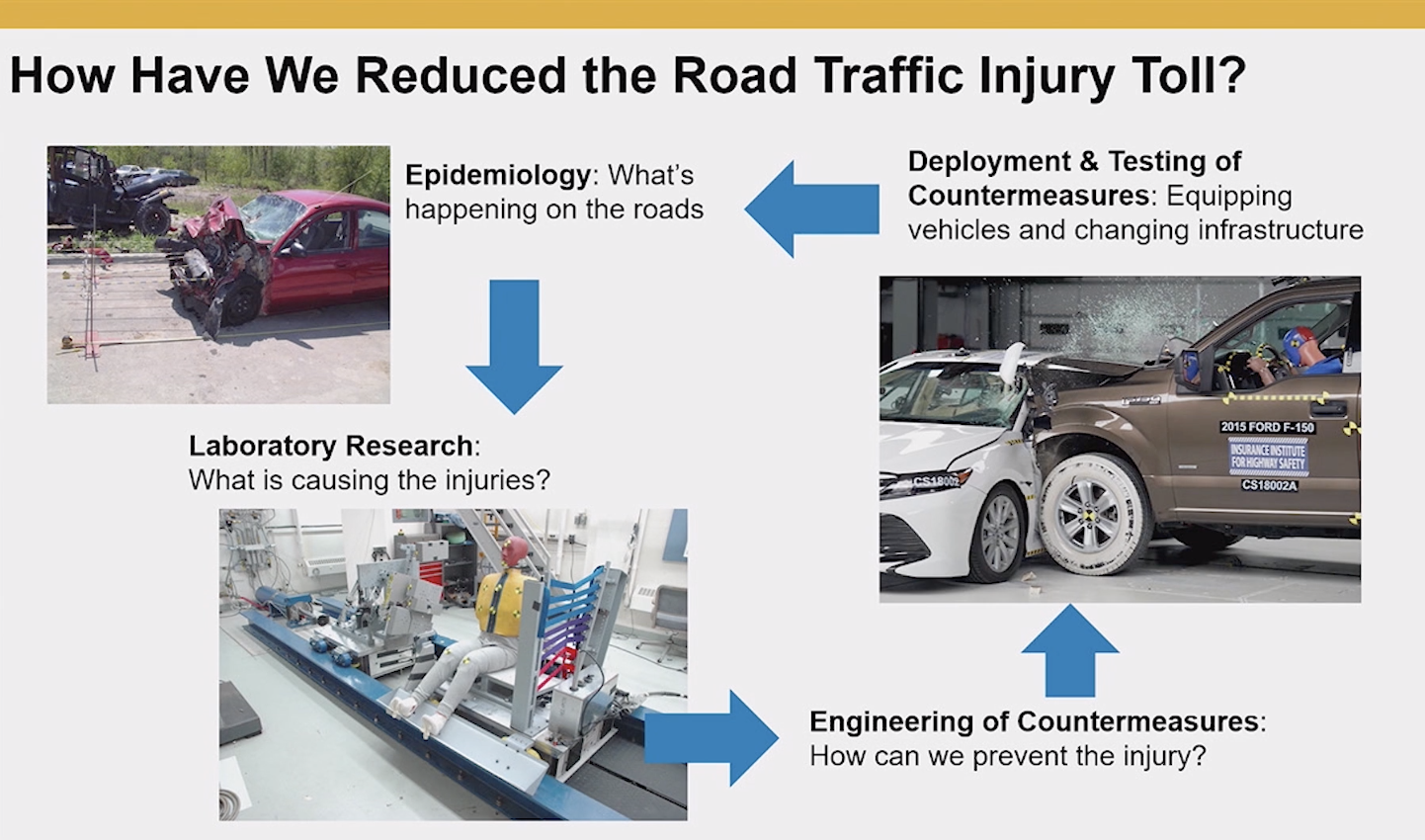
I was pleased to have the opportunity to give a keynote talk at the NFL's Helmet Challenge Symposium this month. The goal of the Helmet Challenge is to make a step-change improvement in the performance of football helmets. The symposium was attended by a wide range of experts from advanced manufacturing and materials science, as well as injury biomechanics. My talk focused on lessons from the automotive industry, which has seen dramatic improvements in crash safety through systematic application of science and engineering. I emphasized the critical role of computational modeling that has enabled the rapid advancements in crash safety we've seen in recent years.
Update: 2019-10
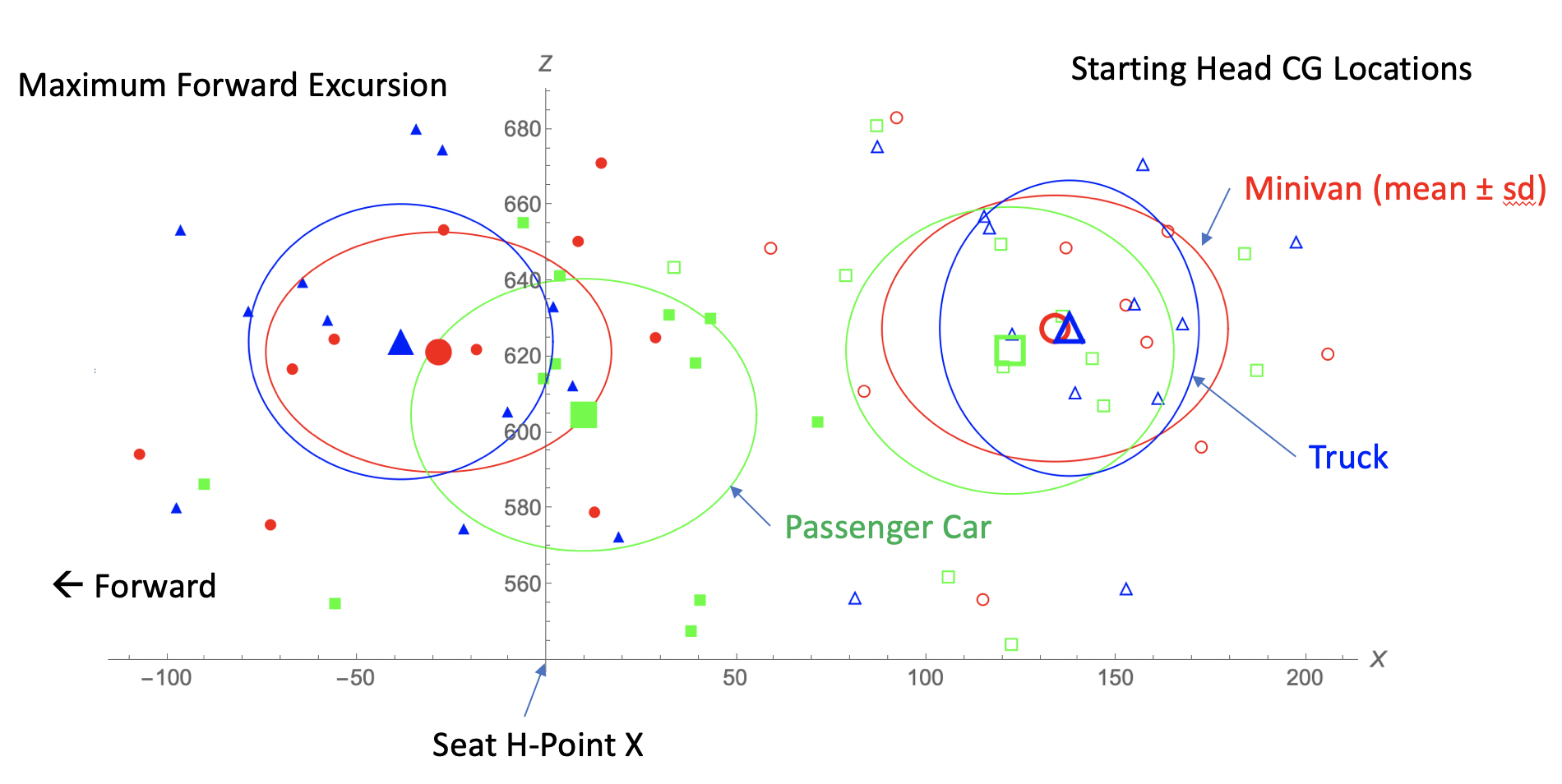
I attended the AAAM annual conference, held in Madrid. (Thanks to Dr. Fran Lopez-Valdez and our excellent hosts at Comillas Pontifical University!) I presented an overview of recent work we did looking at front-seat passenger responses to abrupt vehicle maneuvers. This work, which was also published in Traffic Injury Prevention, compared head excursions in braking and lane change across three vehicles. We found unexpectedly small forward excursions in braking in one vehicle, but overall the differences were small compared to intersubject variability that is not explained by passenger characteristics. We are continuing this work with a large-scale study of 90 men and women with a large range of initial postures and positions.
Update: 2019-09
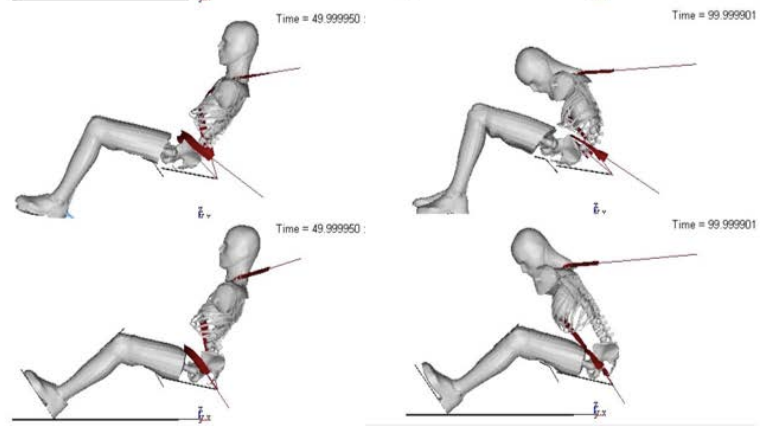
I attended the IRCOBI Conference in Florence this month. My colleague Kyle Boyle presented a paper describing recent simulation studies he conducted to assess possible outcomes for reclined passengers in frontal crashes. This work was conducted to guide the design of a PMHS test series we will begin in the coming months. The simulations used the GHBMC midsize-male simplified model. This study was notable in using an empirical posture-prediction model for positioning the human body model. (Our paper on reclined passenger posture and belt fit has recently been published at Traffic Injury Prevention.) Although the GHBMC model has not been validated for these reclined conditions, the results suggest that preventing submaring in reclined postures will require changes in belt anchorage locations. Future work will consider individuals with higher BMI, who our previous studies suggest are at higher risk of submarining.
Update: 2019-07
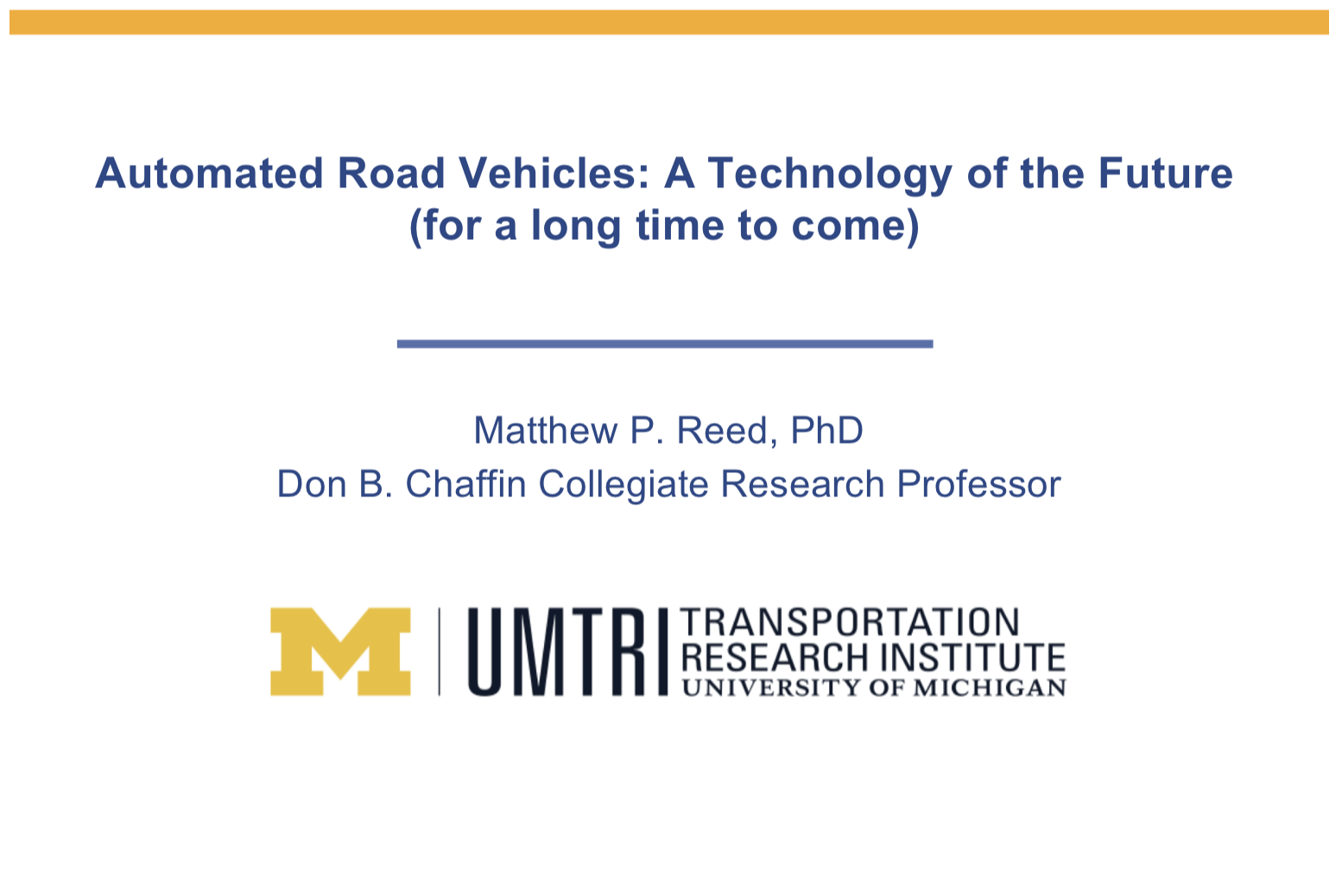
I gave a presentation this month at the IQPC Seating Innovations conference in Canton, MI. This annual event draws engineers and designers from across the auto industry to discuss industry directions and new technologies. I presented an overview of research at U-M that points to a much longer phase-in for automated road vehicles than most of the industry hype would suggest. Aside from the technical challenges of handling inclement weather, road hazards, and other features of normal driving, we are looking at current mobility patterns to assess when and for whom automated vehicles would be worth the investment.
Fundamentally, we always ask the question: if the proposed application is so beneficial, why isn't it being provided currently with human-operated vehicles? Of course the answer is usually financial: the funds to pay for the application (say, small-vehicle last-mile services to connect people to public transportation) are not available. Digging deeper, though, the reality is that these services are already being provided below cost in many areas by the money-hemorraging transportation network companies such as Uber and Lyft. The sobering reality is that in any sustainable model for automated vehicle deployment intended to augment public transportation, the costs must be much less than for human-operated vehicles. Given that taxis have never been a high-margin business (even in protected markets), it's difficult to envision the large capital outlays necessary to develop and maintain AV fleets to provide services for which the market price is so low. Justifying the current high stock prices for money losing TNCs requires that they succeed in obtaining sufficient monopoly power that they can raise prices to profitable levels.
Meanwhile, though, real damage is being done by the hype to support for public transportation. States are seriously looking at spending millions of dollars restriping roads to make the lines more visible to (very expensive) Level-2 vehicles rather than focusing their efforts on improving public transportation or even just fixing bridges. There is a clear and present danger that legislative and regulatory capture by flashy tech companies will divert scarce transportation funds to improving the commutes of wealthy people already exceptionally well served by the US transportation system at the expense of improving transportation for those currently poorly served.
Importantly, it doesn't have to be that way. If AVs can eventually be operated (including acquision and maintenance costs) for substantially less than human operated vehicles (and with similar robustness to weather, construction, and other disturbances), public transportation could be revolutionized in ways that improve equity, particularly for Americans who can't afford privately owned cars. But right now, Uber, Lyft, and other TNCs operating below cost are siphoning riders and revenue from public transit while increasing road congestion for everyone. This is pretty good for their users (I'm one of them), who are getting their near-term transportation services subsidized, but ominous for the transportation system as a whole. Combating the relentless AV hype machines will take data and reasoned argument, so we will collaborate with others in this domain to focus research and outreach efforts on financial realism, contextual assessment, and equity considerations around road vehicle automation. The long-term goal of AV deployment should be to improve accessibility while reducing the inequities inherent in our current system that essentially forces people to own cars.
Update: 2019-06
My colleague Dr. Jingwen Hu and I attended the 2019 ESV Conference in Eindhoven this month. Compared with the last ESV conference in 2017, this conference featured a great deal more realism about the challenges of vehicle automation and confronting the reality of mixed fleets in the coming decades. Among the realities is that advances in driver assistance systems will continue to move the safety goalposts for automation, reducing the potential benefits.
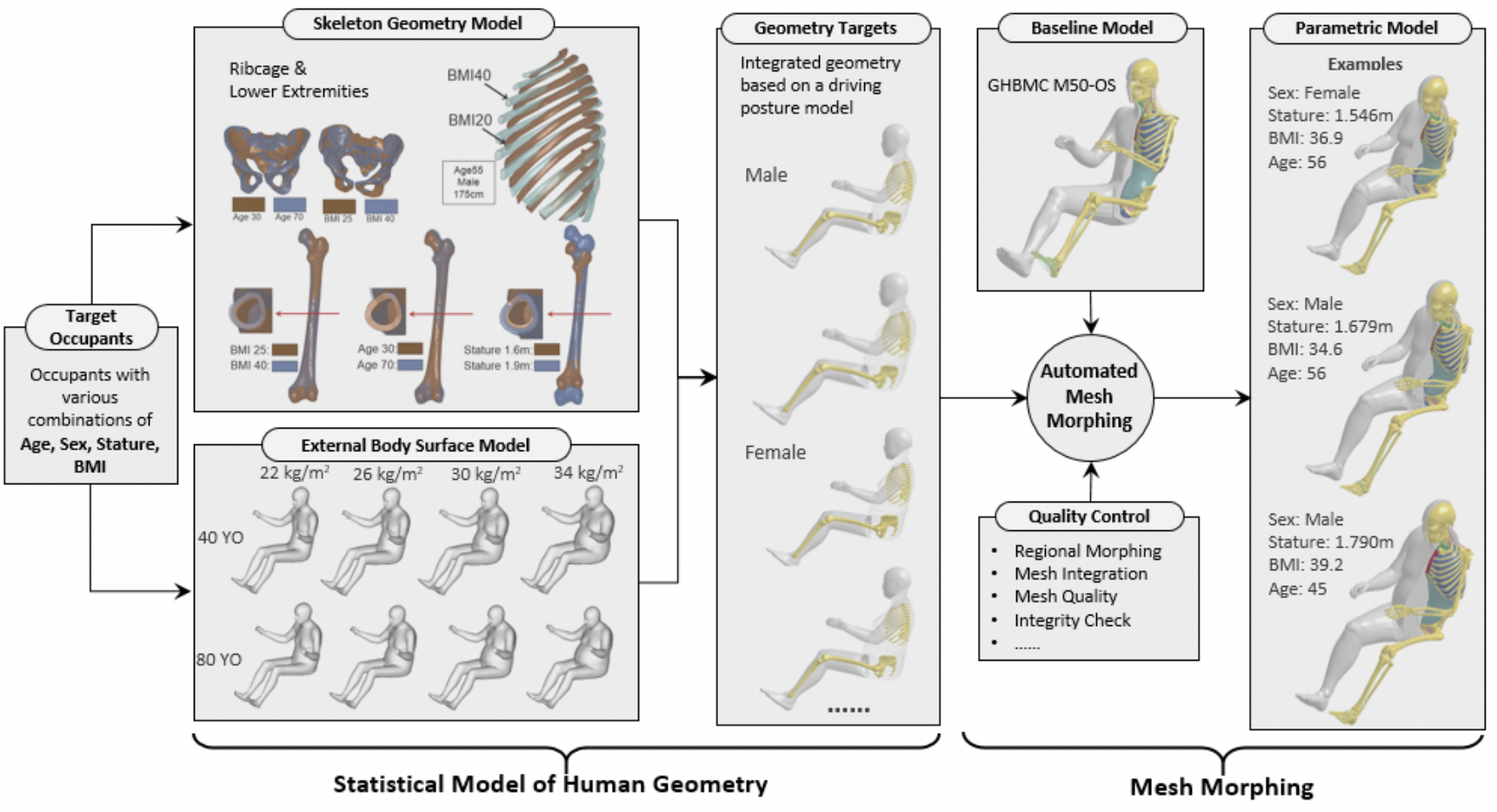
Dr. Hu presented an overview over our most comprehensive effort to date to use our parametric human body modeling methodology to study the effects of driver characteristics on crash injury. From field data, we know that most occupants are at higher risk in crashes than the young midsize males best represented by the most widely used crash test dummies. In the study presented at ESV and published in Traffic Injury Prevention, Dr. Hu's team generated 50 male and 50 female human body models representing a large percentage of the US adult population with respect to stature, body weight, and age. This is an order of magnitude larger number of finite-element human body models previously generated in a single study. To do this work, we needed to develop fully automated methods to morph and posture the FE models within the simulated vehicle. We used validated driver posture prediction models, also a first in this domain.
The results showed large differences in safety in frontal impact depending on body size and shape. This line of research has the potential to guide the development of adaptive restraints that can provide people with a wide range of body size and shape with a similar level of protection in crashes.
I presented an overview of our recent research on reclined postures. In this talk, I focused on changes in belt fit associated with recline. On average the lap portion of the belt moved rearward relative to the pelvis as the participants reclined from back angles of 23 to 53 degrees. Because the pelvis is also rolling rearward with recline, this change in belt fit may make it more difficult to properly restraint the pelvis during a crash. We simulated a seat-integrated restraint in this study, moving the upper anchorage 1:1 with the seat back. However, the torso portion of the belt at the height of the claviclemoved closer to the midline with increasing recline. This probably doesn't represent a change in safety but may decrease comfort.
Update: 2019-04
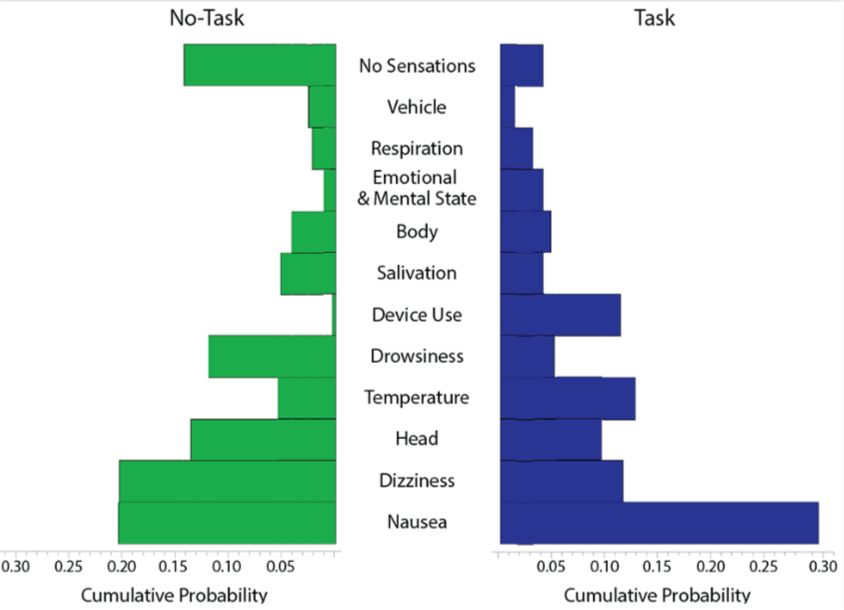
Our group was well-represented at the SAE Congress in April. My colleage Dr Monica Jones presented a paper on sensations reported by participants in a study on vehicle motion sickness she conducted. Motion sickness is an increasing concern due to the fact that passengers are much more susceptible to motion sickness than drivers are. As vehicle automation increasingly changes drivers into passengers, motion sickness can be expected to increase. Solutions are needed that can enable people to take advantage of the potential benefits of automation.

My colleage Dr Daniel Park presented preliminary results from a study examining road lane markings in the context of automated-vehicle sensing systems. Nearly all AV systems currently being tested on-road, as well as driver-assistance systems using similar technologies, rely on detecting lane markings. In this study, Dr Park's team is using a vehicle equipped with lidar and a high-resolution optical camera to monitor the detectability of lane markings on a nearby highway. This project is being conducted in conjunction with the Michigan Department of Transportation, who arranged to have a section of US-23 marked with four different types of paint. Tracking the performance of these materials over time will provide DOTs with useful information on how lane markings can facilitate the adoption of driver-assistance systems (particularly lane-keeping) and future vehicles with higher levels of automation.
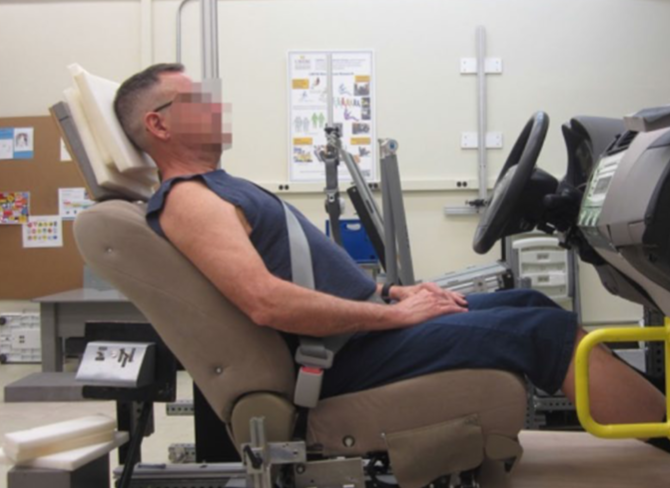
I presented an overview of head and neck postures in highly reclined passenger seating scenarios. The head restraints in current vehicles are designed to reduce the risk of soft-tissue neck injury in rear impacts, rather than being designed to comfortably support the head in reclined postures. If future vehicles are to provide passengers with safe, comfortable rides in resting postures, improvements in seat design will be needed. These results, based on our recent study of reclined passenger postures, provide some useful guidance.
Update: 2019-01
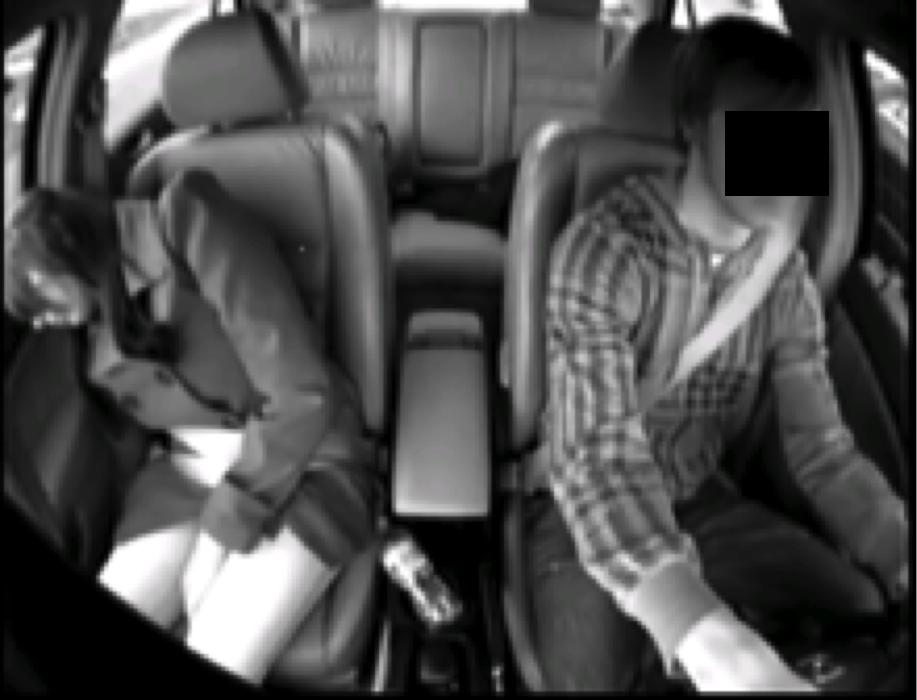
We have many activities underway related to increasingly automated vehicles. Here's an overview of some of the projects.
Occupant Postures, Seating, and Activities
Many concepts for highly automated vehicles envision that vehicle occupants who no longer need to drive will sit in different ways than they do in current vehicles. The two most common suggested alternatives to conventional vehicle seating are (1) highly reclined postures, perhaps for sleeping, and (2) seats facing some direction other than forward. In 2018, we conducted an initial investigation of passenger postures in seats reclined up to 53 degrees. These findings are valuable for understanding the details of skeletal posture in these conditions, which is very important for restraint system design.
We are also underway with a study to examine how passenger's preferences for seat back contour change when they are highly reclined. (We define highly reclined as sufficiently reclined such that head support is needed. Tthis angle varies among individuals, but the transition is typically somewhere between 30 and 35 degrees.) We have built a test seat that allows the contour of the seat back to be dynamically adjusted over a wide range. This will allow us to obtain data on sitter preferences during a variety of activities.
In trying to forecast how passengers in future vehicles will behave, we believe the best approach is to look at the activities of passengers in current vehicles. Surprisingly, passenger behaviors have not been studied extensively. Building on methods we used recently to study driver upper-extremity activities, we are coding videos from on-road trips with front-seat passengers from a previous naturalistic driving study. In 2019, we will gather additional data through video recorders installed in volunteers' vehicles. We anticipate that this data will provide baseline information on the distribution of activities in today's vehicles, which can be used not only to improve the design of current vehicles but also generate ideas for new interior concepts.
Motion Sickness
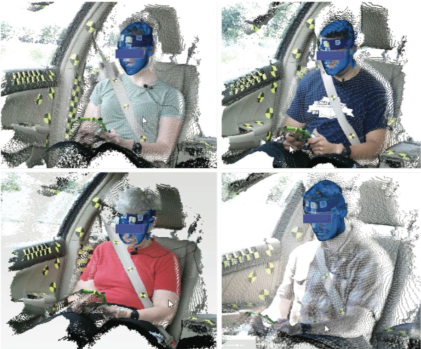
One of the biggest barriers to realizing the vision of cars as mobile workspaces and entertainment centers is motion sickness. A large percentage of the population experiences motion-sickness sensations when they are passengers in cars and light trucks. If this problem is not effectively addressed, many people will probably prefer to drive, since few people get sick as drivers. My colleague Dr. Monica Jones is leading a series of studies addressing this important challenge. Starting with data collection on the Mcity test track, she has moved onto the roads and highways around Ann Arbor to study the manner and rate at which motion sickness accrues. The data convincingly show that motion sickness is a multi-factorial experience, and not just nausea. The rate of increase in sensations is strongly affected by the vehicle acceleration domain and greatly exacerbated by the performance of a screen-based secondary task (in this case, reading on a tablet). One of the most important findings is that recovery from motion sickness above a certain level does not occur during travel; the person needs to be stopped for a relatively long time (~20 minutes) to recover to baseline. Many questions remain to be resolved about the etiology of motion sickness in vehicles. A surprising number of people seem to think this is a solved problem. In fact, *no* validated interventions or countermeasures short of "don't read" or "drive with less acceleration" have appeared in the literature. Nonetheless, the high rate of research and patent activitiy in this area indicates to us that people working with automated vehicle technology have realized that this is a very important barrier to adoption. Our work is ongoing -- contact Dr. Jones for more information.
Crash Safety for Occupants of Future Automated Vehicles
My colleague Dr. Kathy Klinich has looked at the likely distribution of crashes for vehicles that are themselves unlikely to cause a crash due to advanced technology. We've found that during the long phase-in period for crash-avoidance technology, occupants of highly automated vehicle will still experience crashes, although with a different distribution of types and severities. We have several efforts underway to gain the knowledge and develop the tools needed to improve safety for occupants exposed to these crashes. Importantly, all of this knowledge will also be valuable for improving protection for passengers in current vehicles.
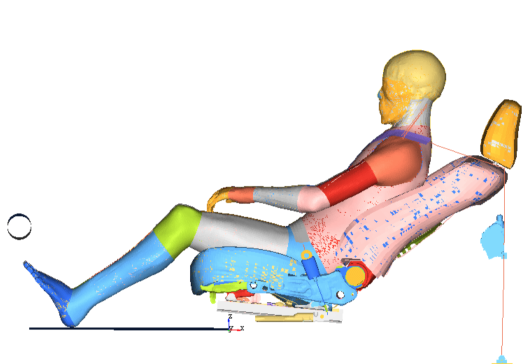
One important line of research relates to the consequences of abrupt crash-avoidance manuevers, such as hard braking. Ideally, the crash avoidance maneuver will be successful, but sometimes a crash will still occur. Previous studies from our lab and others have shown that pre-crash braking or abrupt lane changes can substantially alter passenger posture away from the typical postures used for restraint system optimization. We are currently analyzing data from a recent study examining whether these motions differ across vehicles for similar events. In summer 2019, we will be conducting another large-scale test-track study gathering more data on passenger responses with different starting postures.
We are also underway with computational modeling of these pre-crash occupant motions. In a NHTSA-funded study led by Dr. Jingwen Hu, we are modifying the GHBMC simplified midsize-male model to respond dynamically to perturbations in the ~1g range. We anticipate that the model will be capable of realistic response to a wide range of horizontal perturbations. We will use our human volunteer data to tune and validate the model.
Crash Protection in Reclined Postures
We have recently kicked off a large-scale, collaborative effort to conduct basic biomechanics research addressing protection for reclined passengers. Preliminary modeling studies from our lab and others have shown that belt restraints can perform poorly for reclined passengers in frontal impacts, and the kinematics and loading of passengers in severe rear impacts also creates protection challenging. First, however, we need to gain sufficient understanding of occupant response in these conditions that we can accurately simulate these conditions with both computational and physical models (i.e., crash test dummies). In collaboration with the Medical College of Wisconsin, we are conducting a large-scale sled-test series with post-mortem human subjects focused on gathering response data across a wide range of recline and restraint conditions. Scheduled to continue into 2020, this program will yield highly valuable data that will be critical for developing advanced protection systems for occupants of future vehicles.
©2024 Matthew P. Reed and The University of Michigan
 ORCID:
ORCID: 